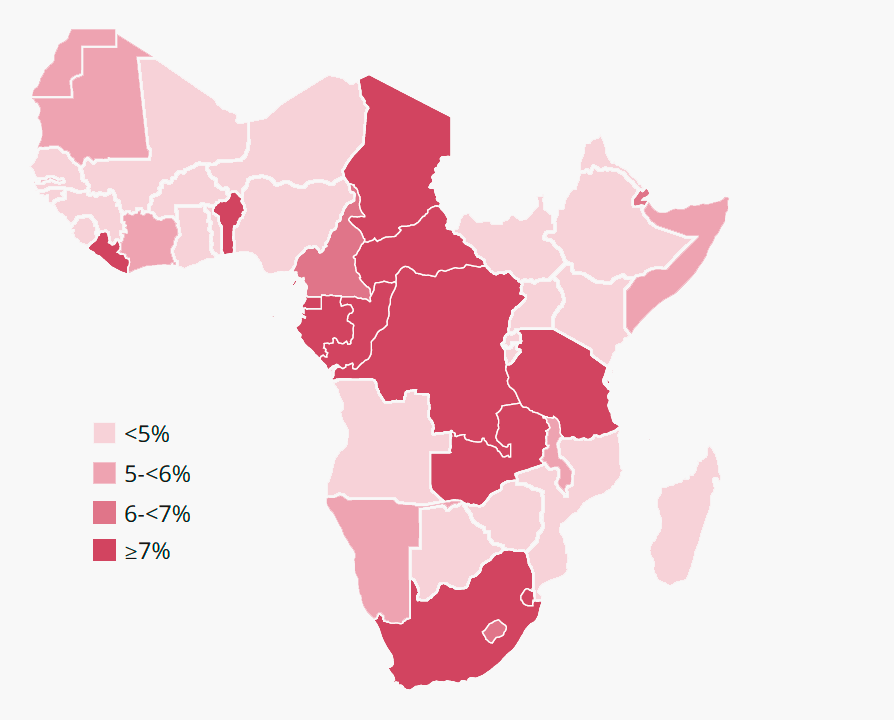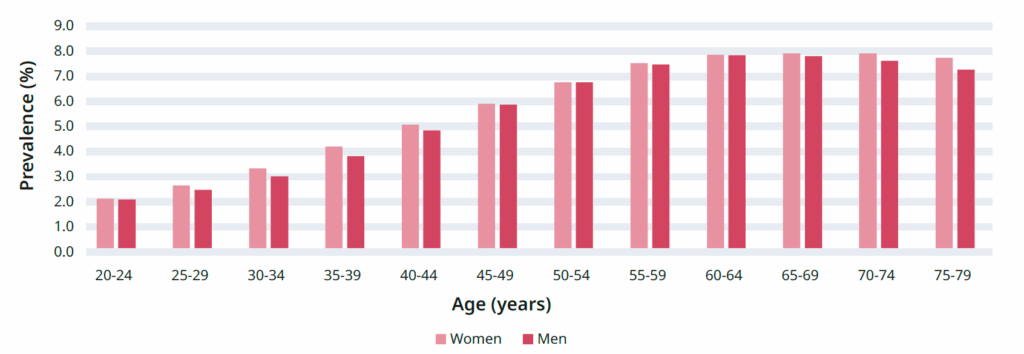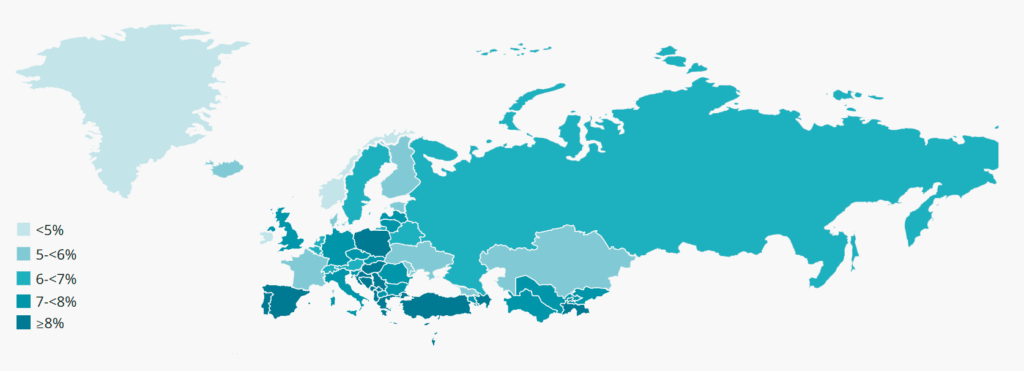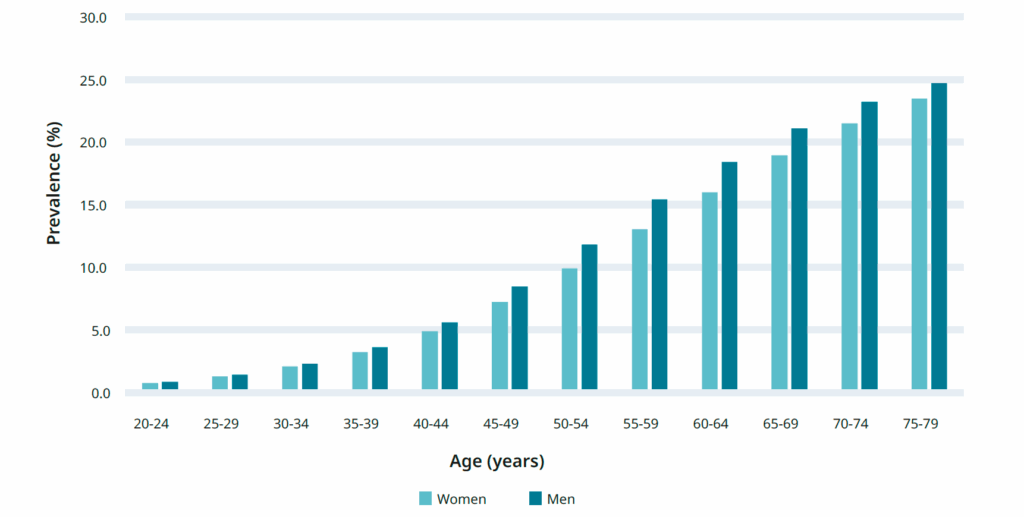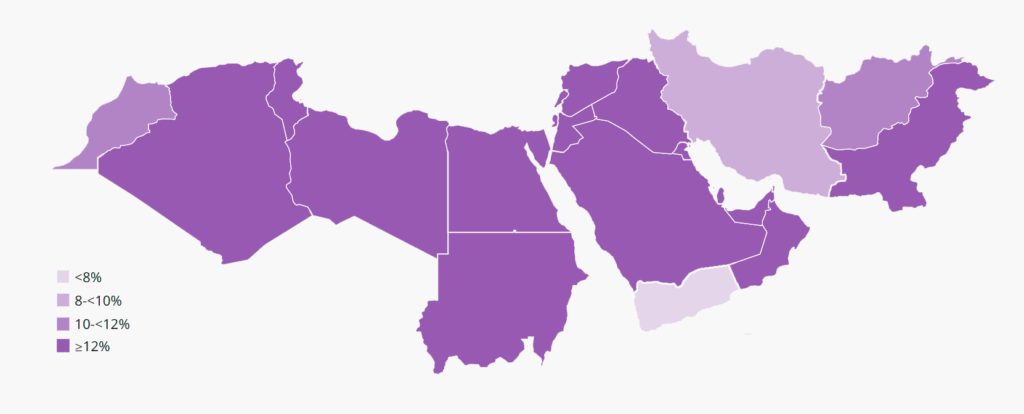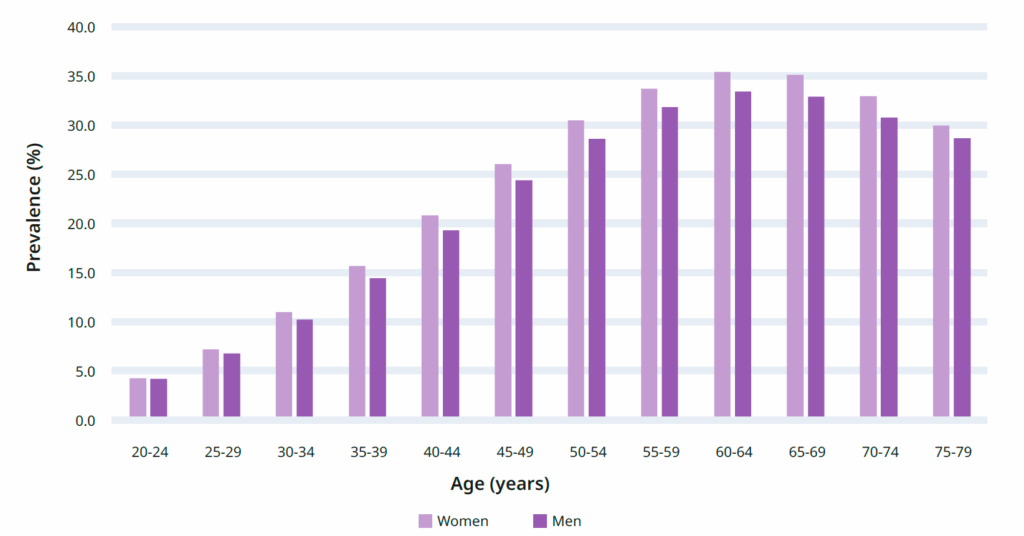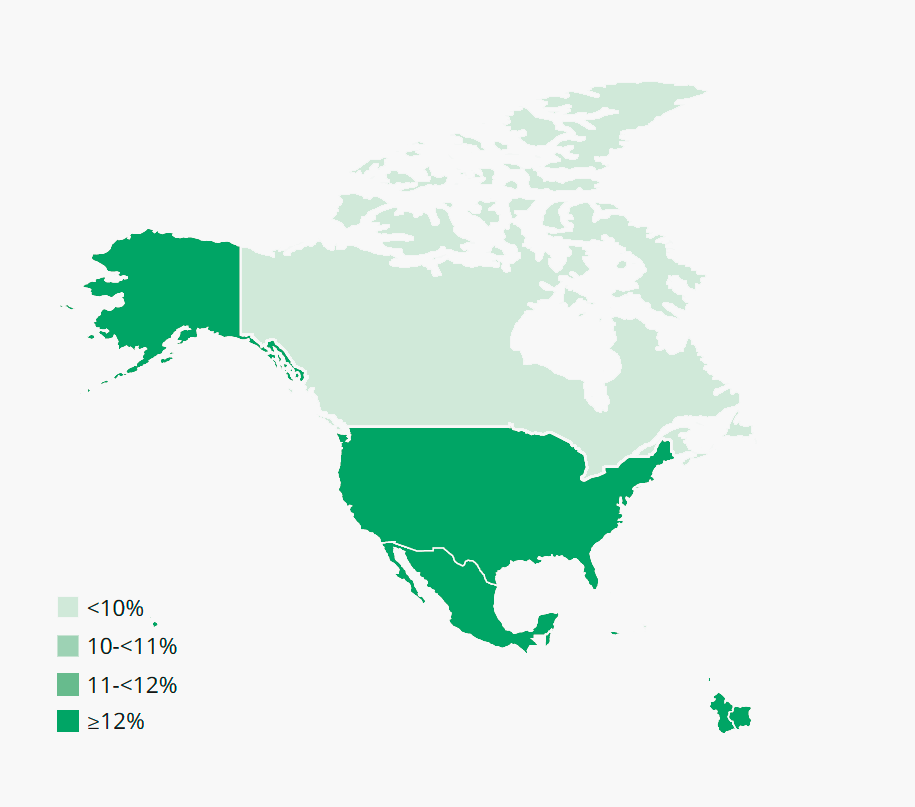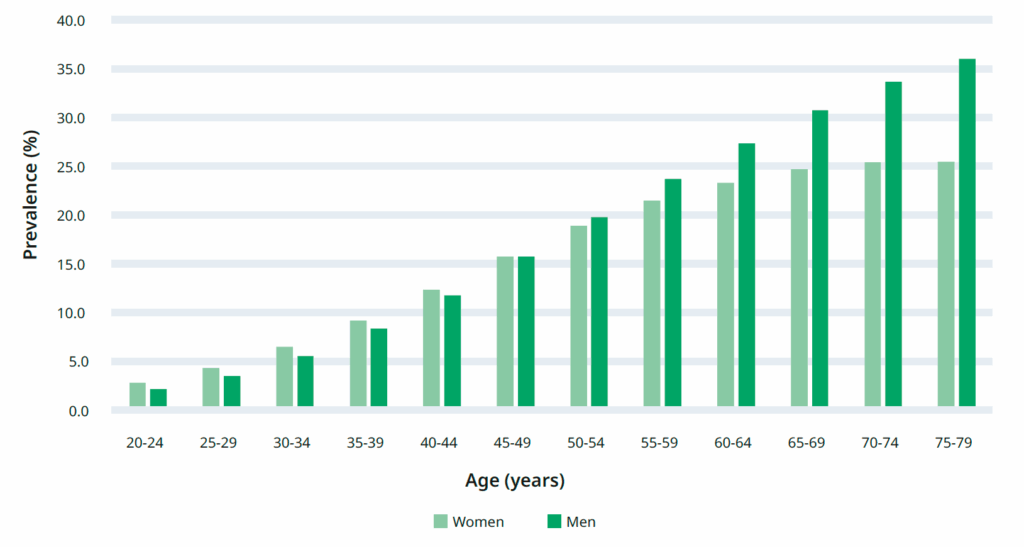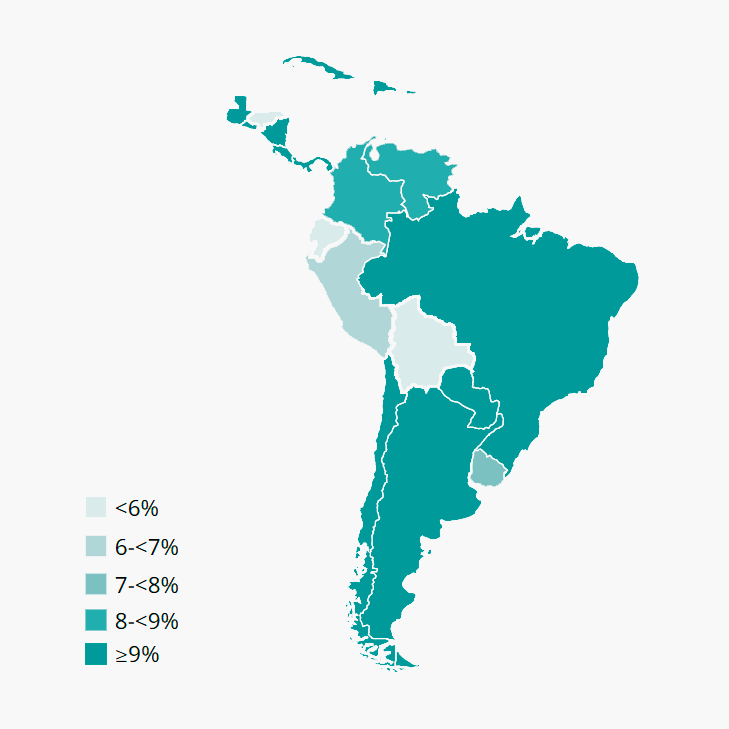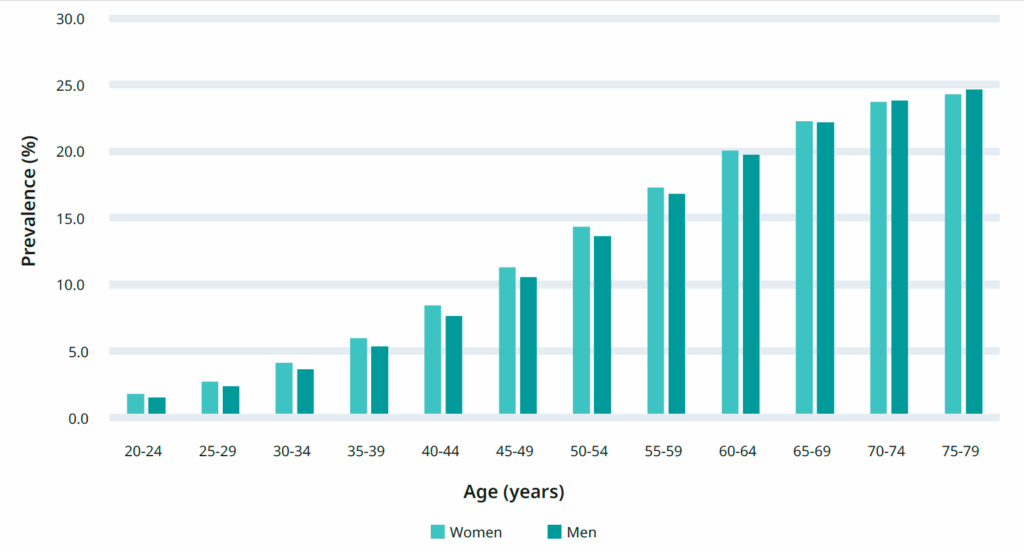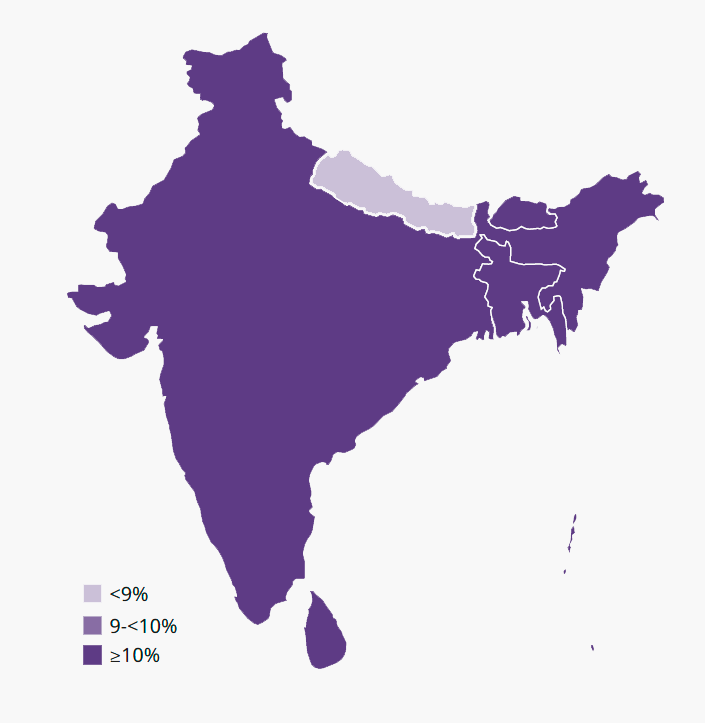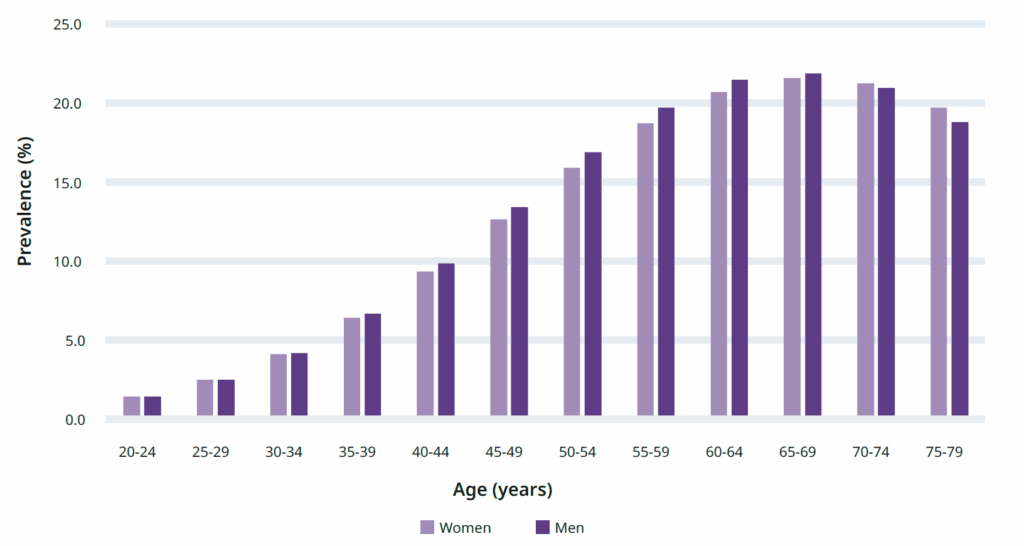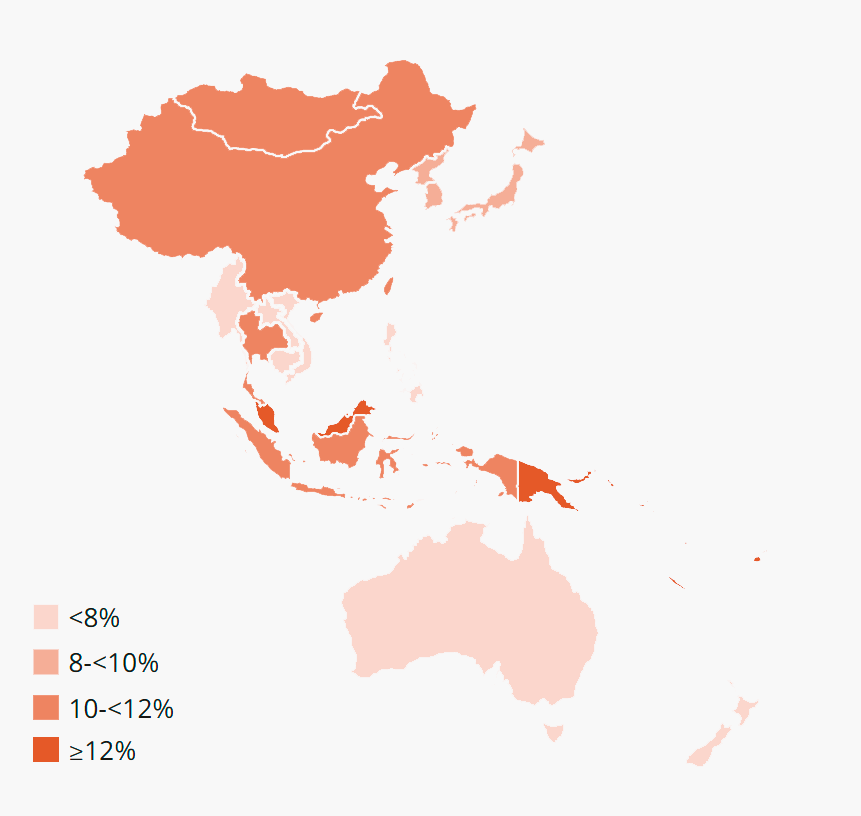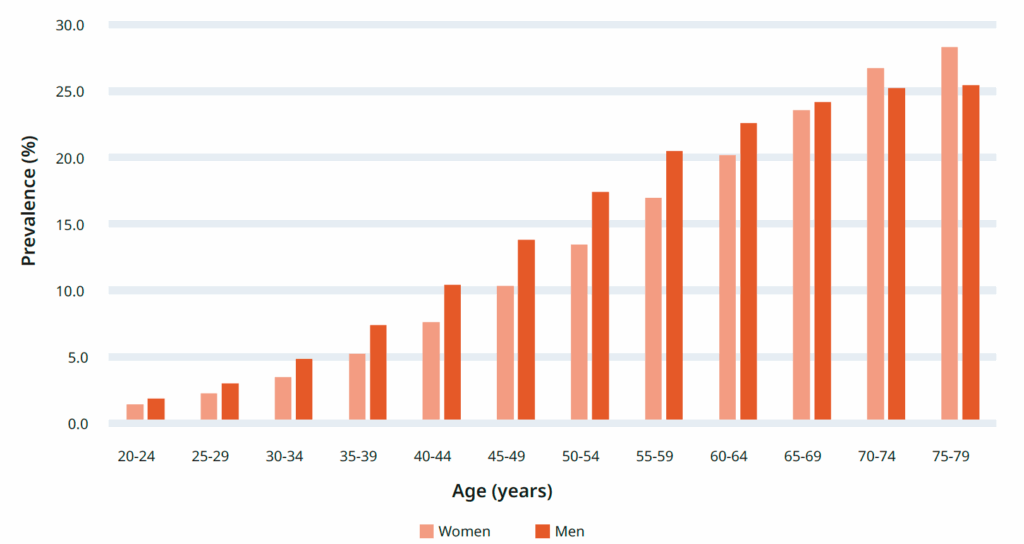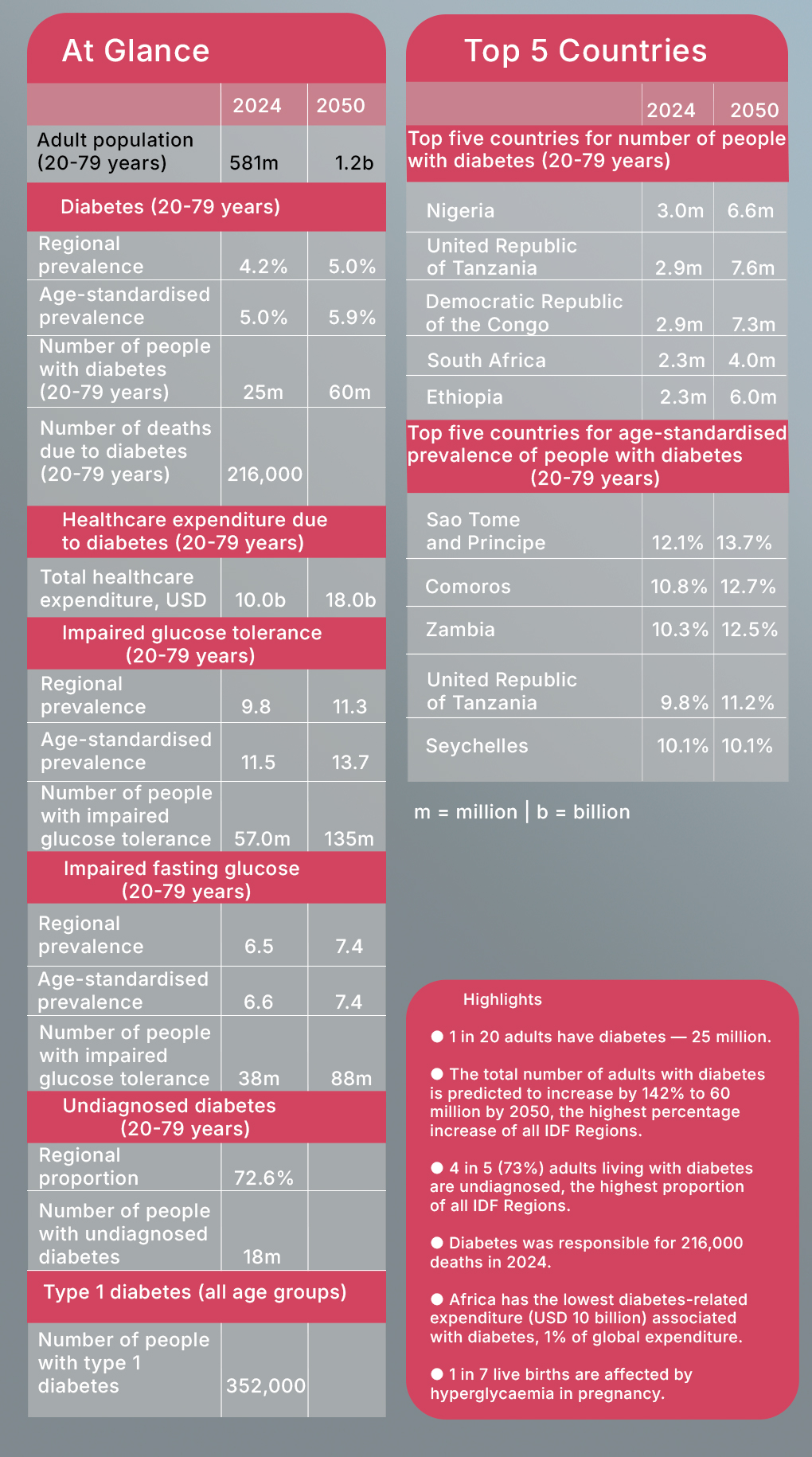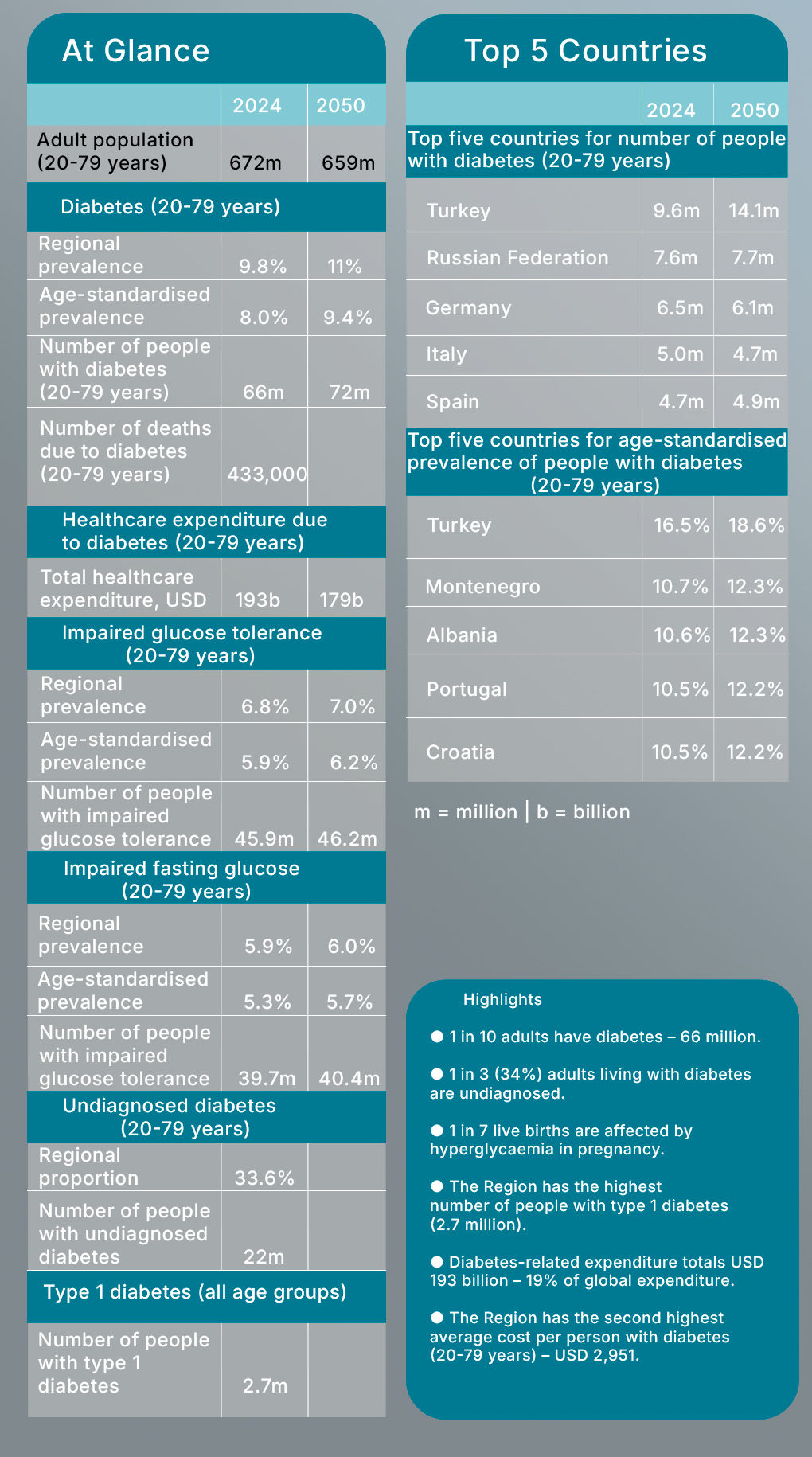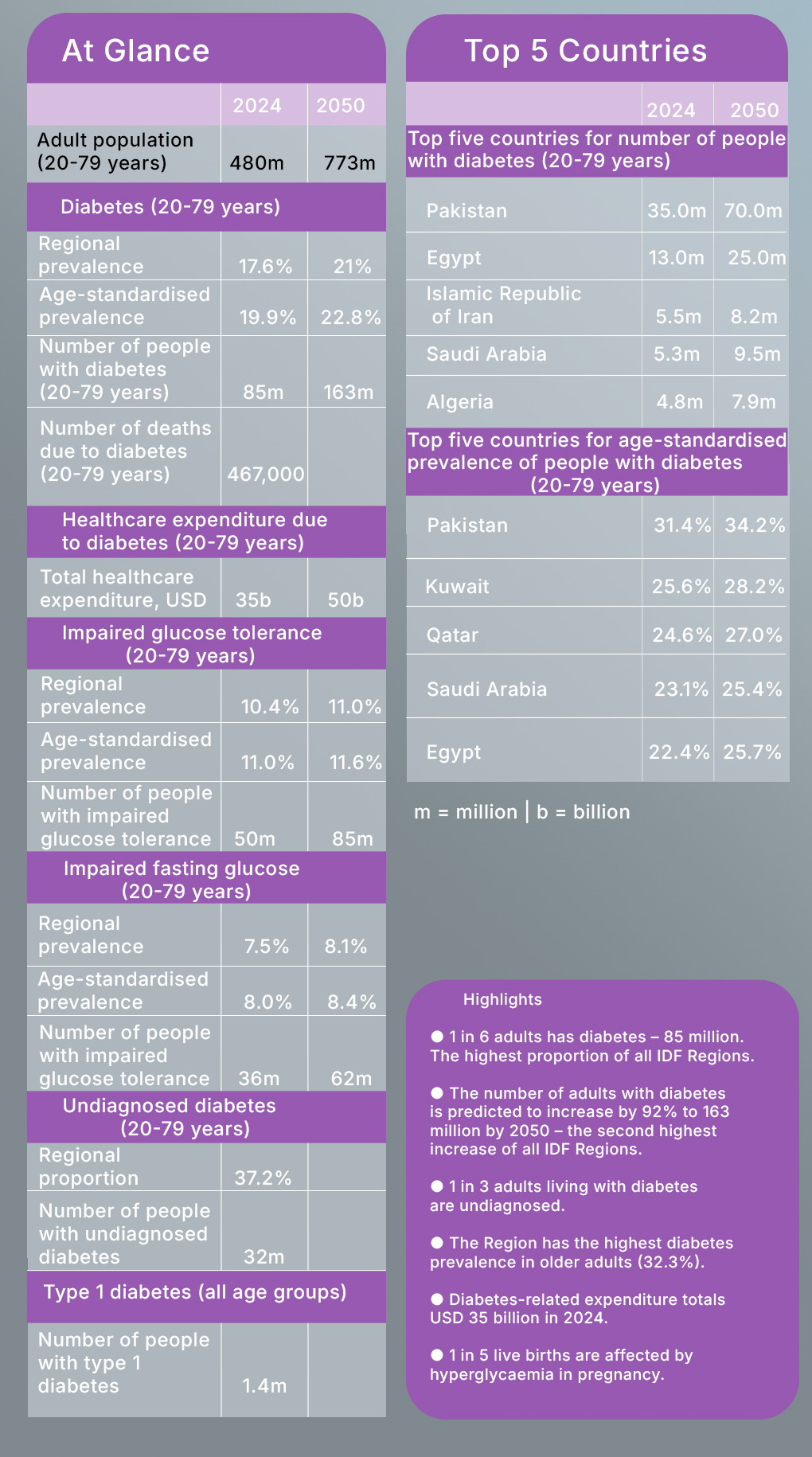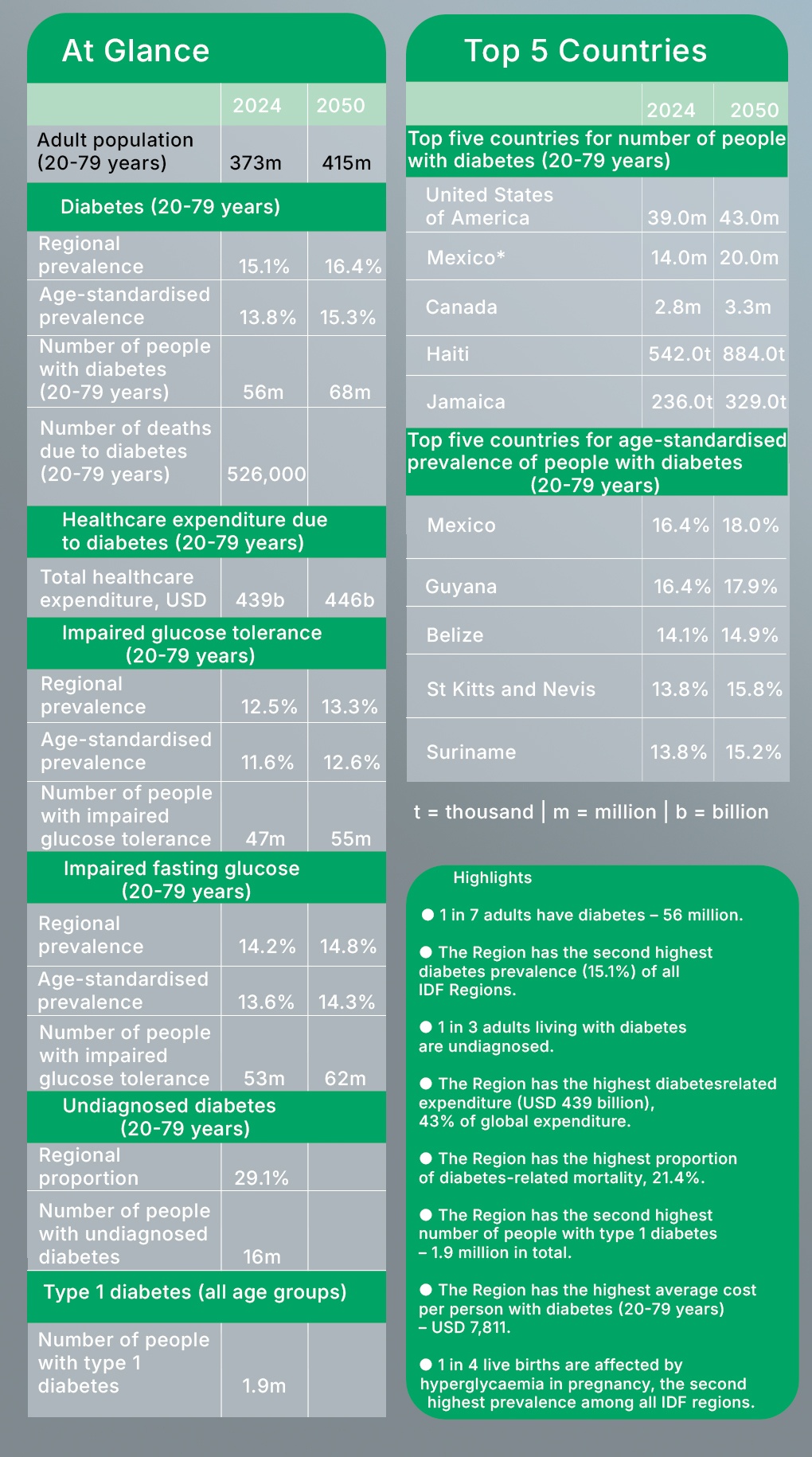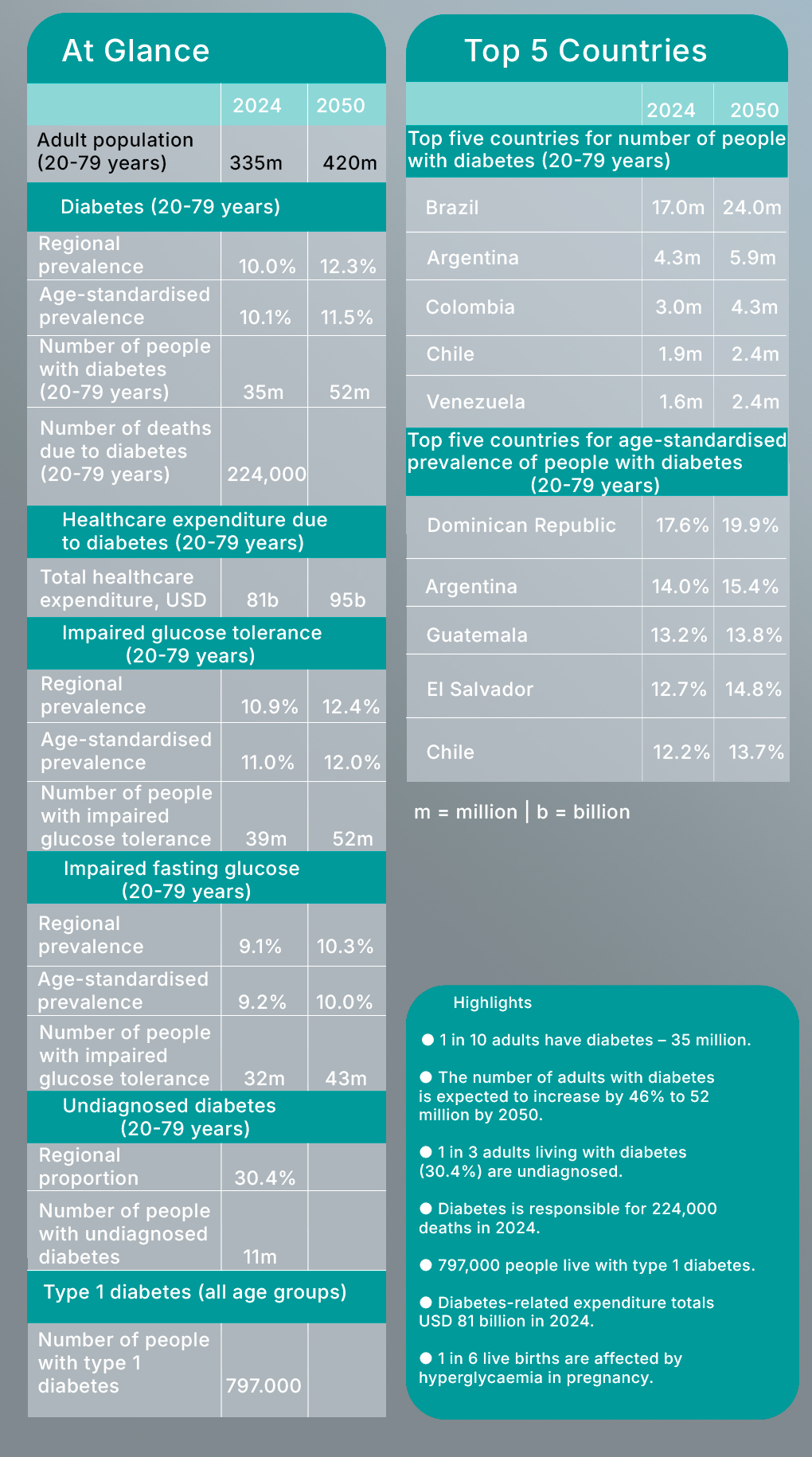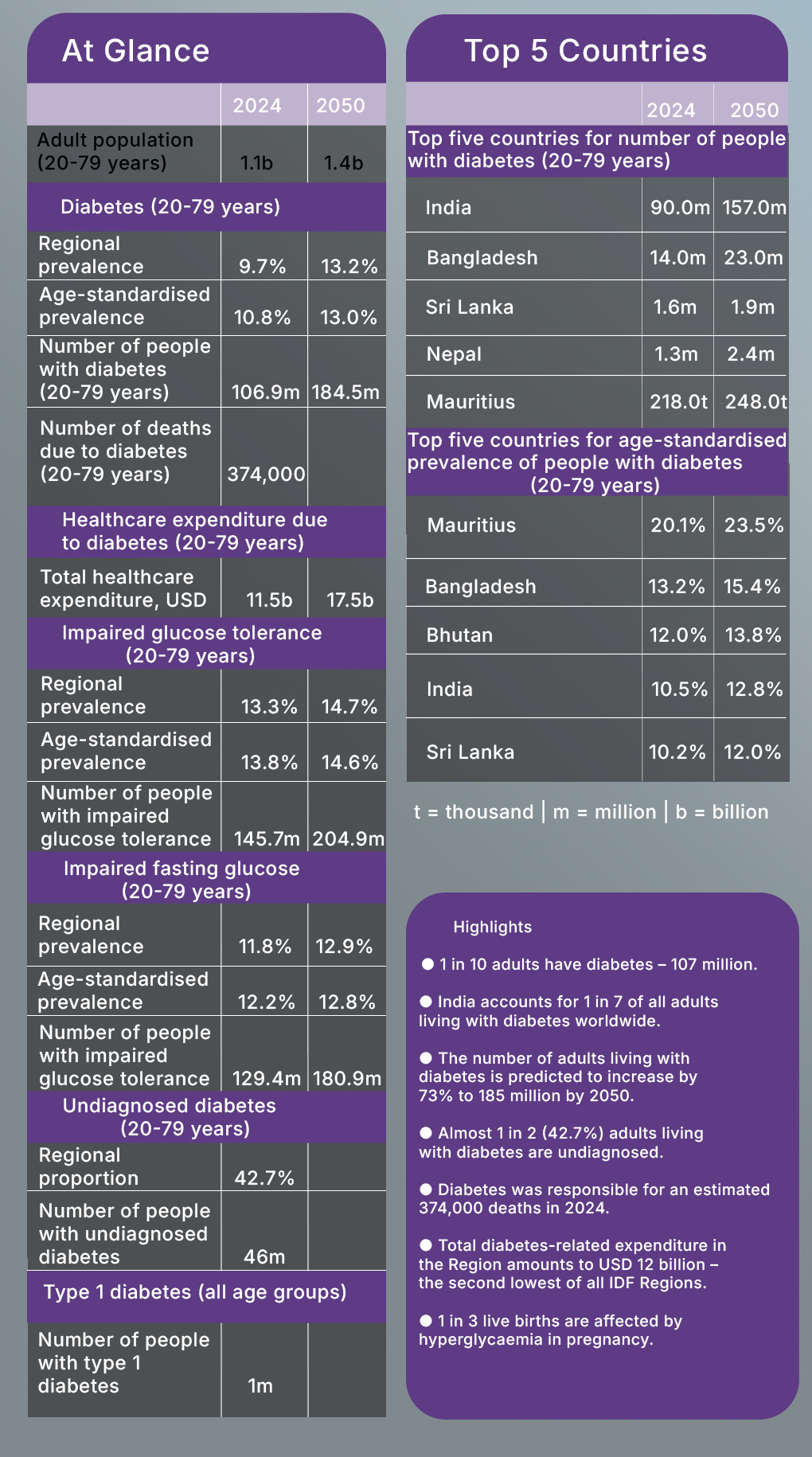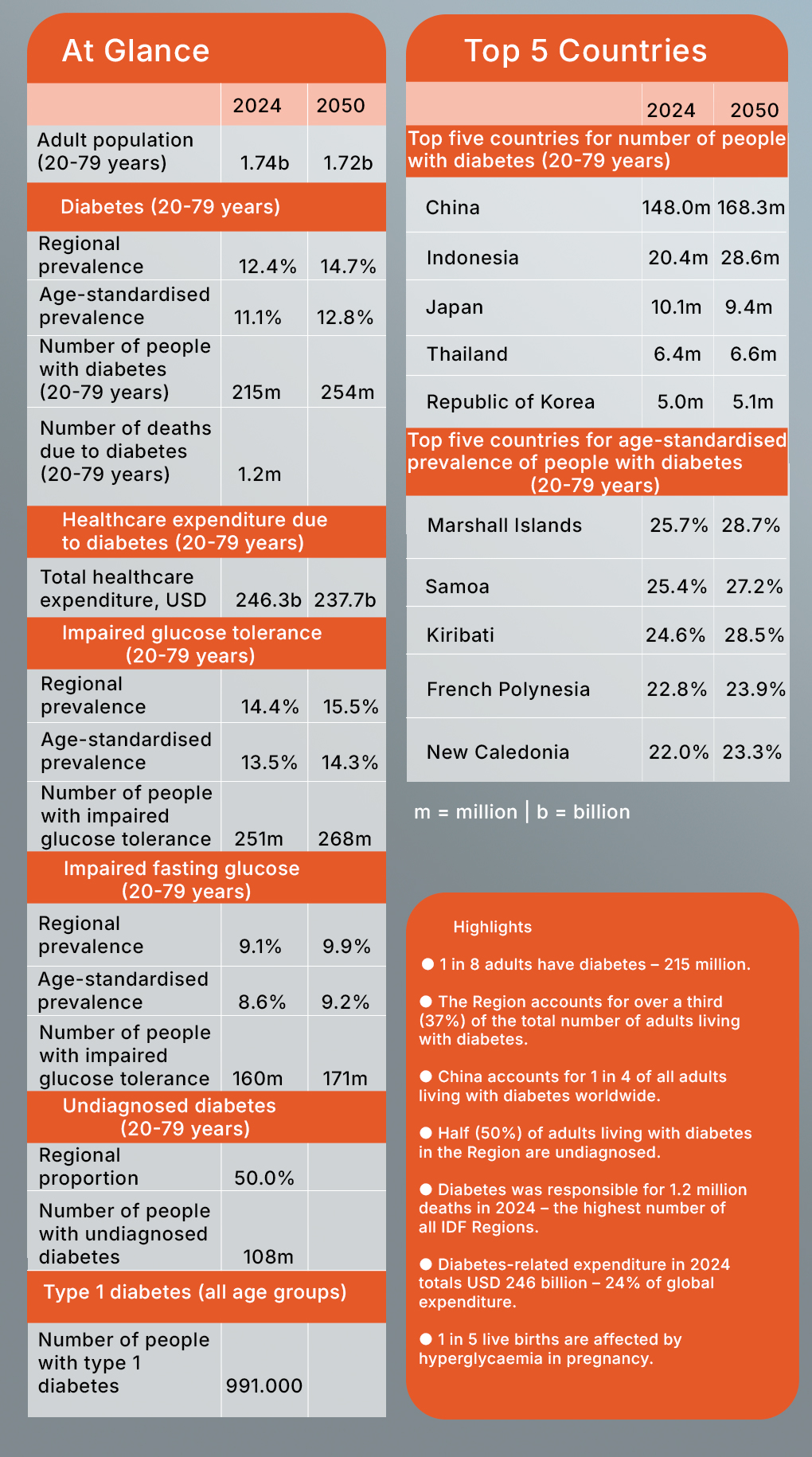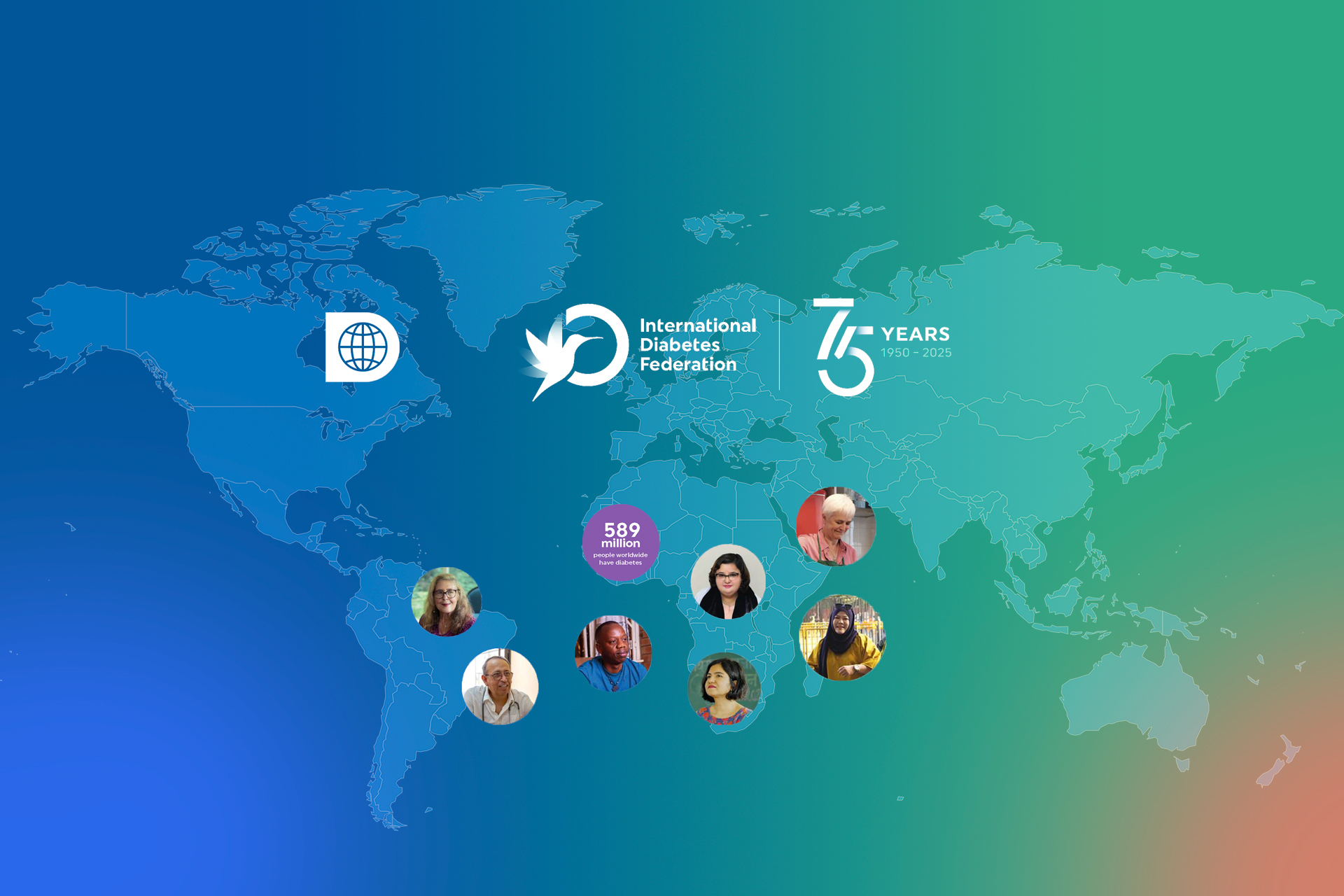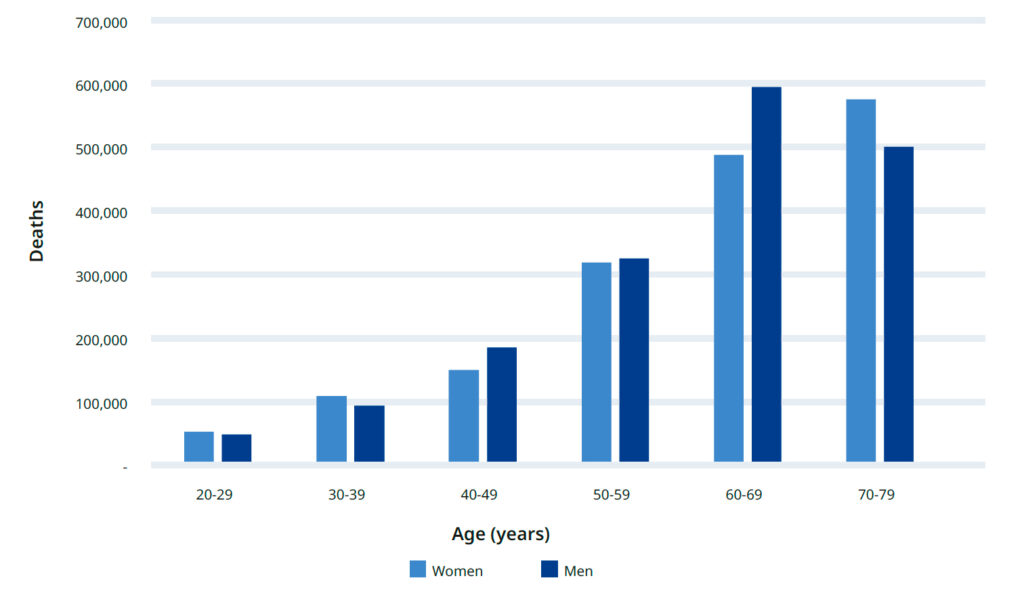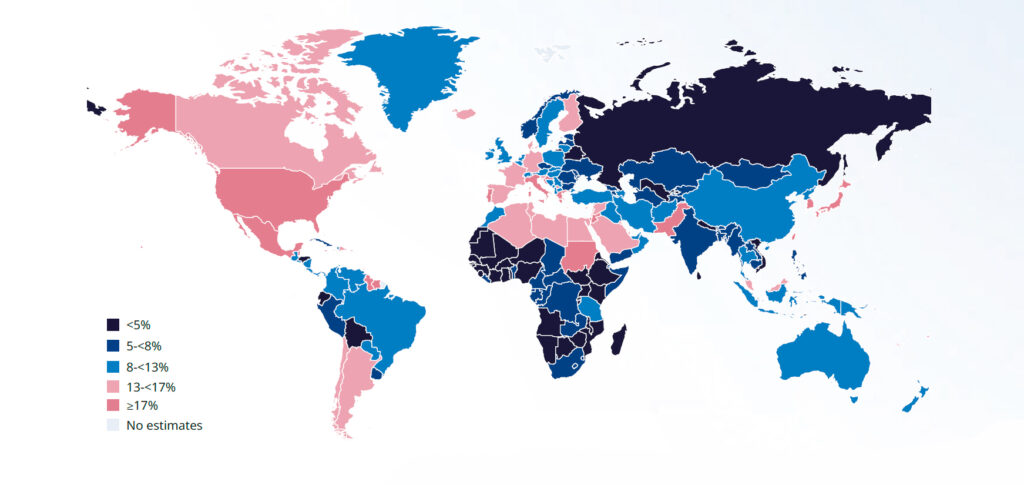
Diabetes in numbers
- Data
- Worldwide

-
Prevalence by countries
-
Death rate from diabetes
-
Top 5 Countries
The Diabetes Atlas highlights the growing impact of diabetes across the world and the proven and effective actions that governments and policy-makers must urgently take to tackle it.

DIABETES IS A GLOBAL EMERGENCY
Diabetes is one of the biggest global health emergencies of the 21st century. And it reached pandemic proportions. The International Diabetes Federation (IDF) estimates that in 2021, 536.6 million people worldwide had diabetes, and the disease accounted for more than $966 billion in global healthcare spending. The IDF estimates that in 2045 there will be 783.2 million diabetic patients worldwide and healthcare costs of US$1.054 billion.
According to the same estimates, diabetes is the third leading cause of death after cardiovascular diseases and cancer. In 2021 only, about 6.7 million deaths worldwide were directly attributable to diabetes. This is equivalent to one death every eight seconds and is estimated to be associated with 12.2% of global deaths from all causes among the world’s population. More than 80.6% of deaths occur in middle- and low-income countries.
Given significant therapeutic value of insulin, all manufacturers still lack production capacity to meet the demand and ensure adequate and stable supply. As estimated, 60-65 million people do not have access to this life-saving medicine, which is an essential and urgent need. Universal availability of insulin for people with diabetes is seen as a basic human right, but almost a century after its discovery, insulin remains largely unavailable, expensive, or both. To date, the coverage of the need for insulin in the world is about 18-20%.
Diabetes by region
Diabetes in Africa 2024
Estimates are provided for 49 Sub-Saharan African countries and territories in the IDF Africa (AFR) Region. For this edition of the IDF Diabetes Atlas, a total of 35 data sources from 27 countries met the inclusion criteria. About half (45%) of the countries in the IDF AFR Region lack high-quality, in-country data sources. Only three countries (Cape Verde, Gambia and Sao Tome and Principe) had studies conducted within the past five years. Despite the lowest prevalence estimate of 5.0% among IDF Regions, the expected increase in the number of people with diabetes by 2050 is the highest at 142%, reaching 60 million. The AFR Region is also predicted to have the highest increase in the number of people with impaired glucose tolerance and impaired fasting glucose by 2050, reaching 135 million (138% increase) and 88 million (134% increase) respectively. The proportion of undiagnosed diabetes is also highest of all the IDF Regions at 72.6%. Diabetes care receives the lowest level of investment in the AFR Region, with only 10 billion USD spent on diabetes, representing a mere 1% of the total spent worldwide, despite the Region being home to 11.4% of people with diabetes worldwide.
Diabetes in Europe 2024
Estimates were produced for 60 countries and
territories in the IDF Europe (EUR) Region. A total of
71 data sources from 41 countries met our inclusion
criteria and were used to generate the diabetes
estimates for adults in the Region. Estimates for
nine countries (Bulgaria, United Kingdom, Russian
Federation, Lithuania, Denmark, Israel, Italy, United
Kingdom, Uzbekistan) were based on studies
conducted within the past five years.
The estimated diabetes prevalence (9.8%) and the
number of people with diabetes (66 million) in the
EUR Region will see a 10% increase by 2050. The EUR
Region has the highest number of people with type
1 diabetes (2.7 million), 15% of whom are people <20
years (419,000). In 2024, an estimated 193 billion USD
was spent on diabetes in the EUR Region, representing
19% of the total spent worldwide. The Region has the
second highest average cost per person with diabetes
(USD 2,951).
Diabetes in Middle-East and North Africa 2024
Estimates were made for 21 countries and territories
in the IDF Middle-East and North Africa (MENA)
Region. A total of 34 data sources from 18 countries
were used to estimate diabetes prevalence among
adults aged between 20 and 79 years. Three countries:
Islamic Republic of Iran, State of Palestine and Jordan
had studies conducted within the past five years.
The MENA Region has the highest regional prevalence
at 17.6% and the second highest expected increase
(92%) in the number of people with diabetes, reaching
a predicted 163 million by 2050. The MENA Region has
1.4 million people with type 1 diabetes. The Region
has the highest percentage (21.6%) of diabetesrelated
deaths in people of working age (<60 years).
Despite being home to 14.4% of people with diabetes
worldwide, only 35 billion USD was spent on diabetes
in the Region, representing 3.4% of the total
invested worldwide.
Diabetes in North America and Caribbean 2024
Estimates were made for Canada, Mexico, the United
States of America and 22 Caribbean countries and
territories in the IDF North America and Caribbean
(NAC) Region. Estimates for diabetes in adults in the
Region were based on 21 data sources, representing
15 of the 22 countries. Estimates for Mexico and USA
were based on studies conducted within the past
five years.
The NAC Region has the second highest diabetes
prevalence among IDF Regions at 15.1%. IDF projects
that the number of people with diabetes in the NAC
Region will increase by 22%, to reach 68 million by
2050. The NAC Region has the second highest number
of people with type 1 diabetes – 1.9 million in total.
The NAC Region has the highest proportion (21.4%) of
diabetes-related mortality to all-cause mortality and
the second highest number of deaths due to diabetes
(526,000) among IDF Regions. The NAC Region has the
highest diabetes-related expenditure (USD 439 billion),
43% of global expenditure, and has the highest
average cost per person with diabetes (20–79 years)
at USD 7,811.
Diabetes in South and Central America 2024
Estimates were made for 19 countries and
territories in the IDF South and Central
America (SACA) Region. Estimates for
diabetes prevalence in adults aged 20–79
years were based on 29 data sources from
15 countries. Five countries: Brazil, Peru,
Brazil, Panama and Bolivia had studies
conducted within the past five years.
IDF projects that the number of people with
diabetes in the SACA Region will increase by
46%, reaching 52 million by 2050. Over the
same period, the prevalence of diabetes will
increase by 23%, reaching 12.3%. In 2024,
81 billion USD was spent on diabetes in
the SACA Region, representing 8% of total
expenditure worldwide.
Diabetes in South-East Asia 2024
Estimates were made for the seven countries and
territories in the IDF South-East Asia (SEA) Region.
All countries except Bhutan had primary data
sources, which were used to generate estimates
for diabetes in adults aged 20–79 years. A total of
nine data sources from these six countries were
used. Estimates for Mauritius, India and Sri Lanka
were based on studies conducted within the past
five years.
IDF projects that the number of people with
diabetes in the SEA Region will increase by 73%,
reaching 185 million by 2050. Over the same period,
the prevalence of diabetes will increase 36% to reach
13.2%. The proportion of undiagnosed diabetes
is the third highest of the seven IDF Regions at
42.7%. The proportion of pregnancies affected by
hyperglycaemia is also the highest at 27.8%.
Only 12 billion USD was spent on diabetes in the SEA
Region, representing a mere 1% of the total spent
worldwide, despite the region being home to 18.2%
of people with diabetes worldwide.
Diabetes in Western Pacific 2024
Estimates were made for 37 countries and
territories in the IDF Western Pacific (WP) Region.
For this edition of the IDF Diabetes Atlas, 40 data
sources from 28 countries were used to generate
estimates of diabetes in adults aged 20–79 years.
Estimates for Australia, Vietnam, Republic of
Korea, Singapore, Malaysia and Mongolia were
based on studies conducted within the past
five years.
The WP Region accounts for over a third (37%)
of the total number of adults living with diabetes.
The WP Region has the third highest prevalence of
diabetes (12.4%) in the world. IDF projects that the
number of people with diabetes in the WP Region
will increase by 18%, reaching 254 million by 2050,
and that the prevalence of diabetes will increase
by 19% to reach 14.7% in 2050. The proportion of
undiagnosed diabetes (50%) is the second highest
of all IDF Regions. Diabetes is responsible for 1.2
million deaths in 2024, the highest number of all
IDF Regions. Diabetes-related expenditure in
2024 totals USD 246 billion, the second highest
of all IDF Regions and representing 24% of
global expenditure.
The global picture of diabetes
Worldwide, a total of 589 million adults aged 20–79 are estimated to have diabetes (11.1% of all adults in this age group). By 2050, the number of adults living with diabetes will rise to a projected 852.5 million.
While the world’s population is estimated to grow 25% over the next 25 years, the number of people with diabetes is estimated to increase by 45%
(Map 2.1, Table 2.1, Map 2.2).
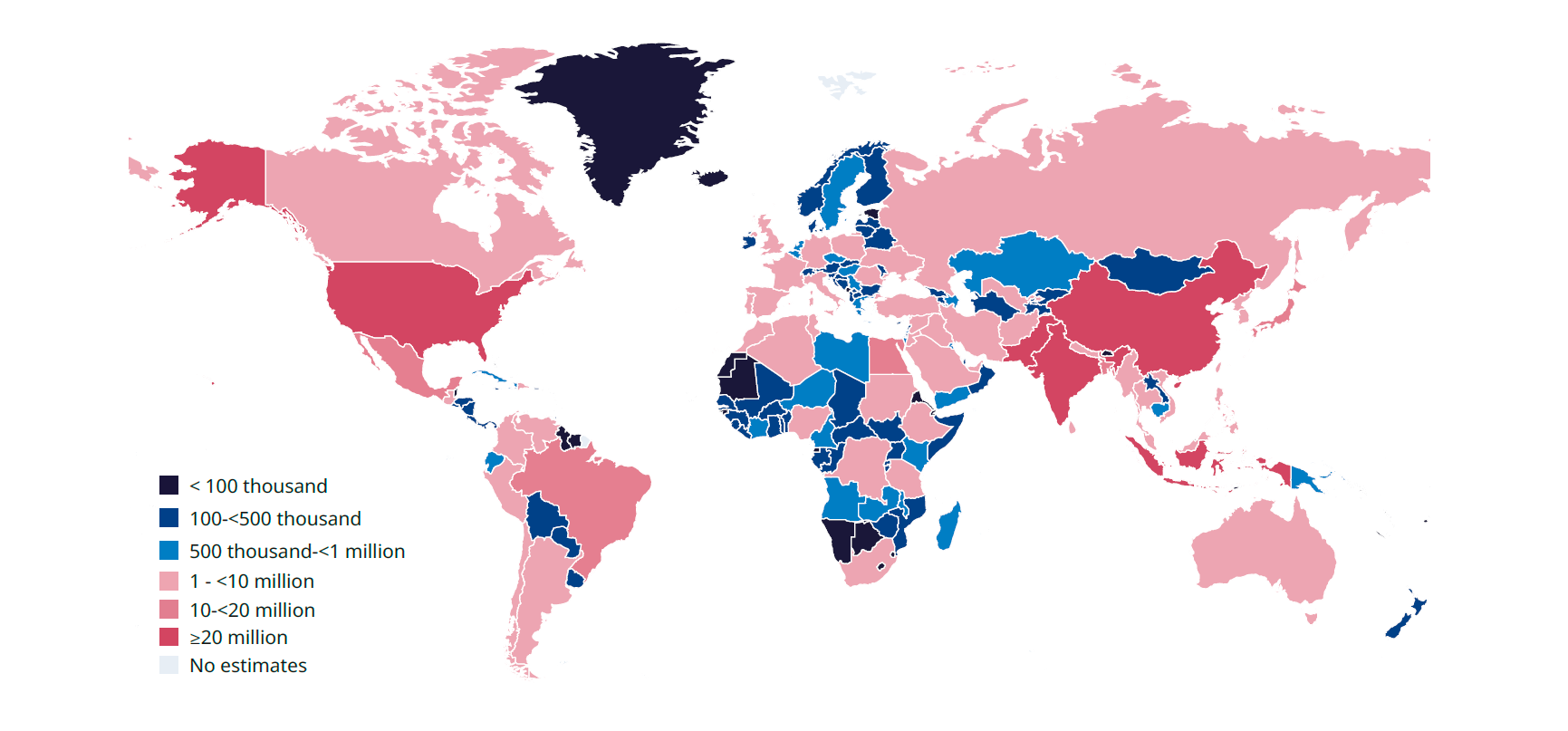
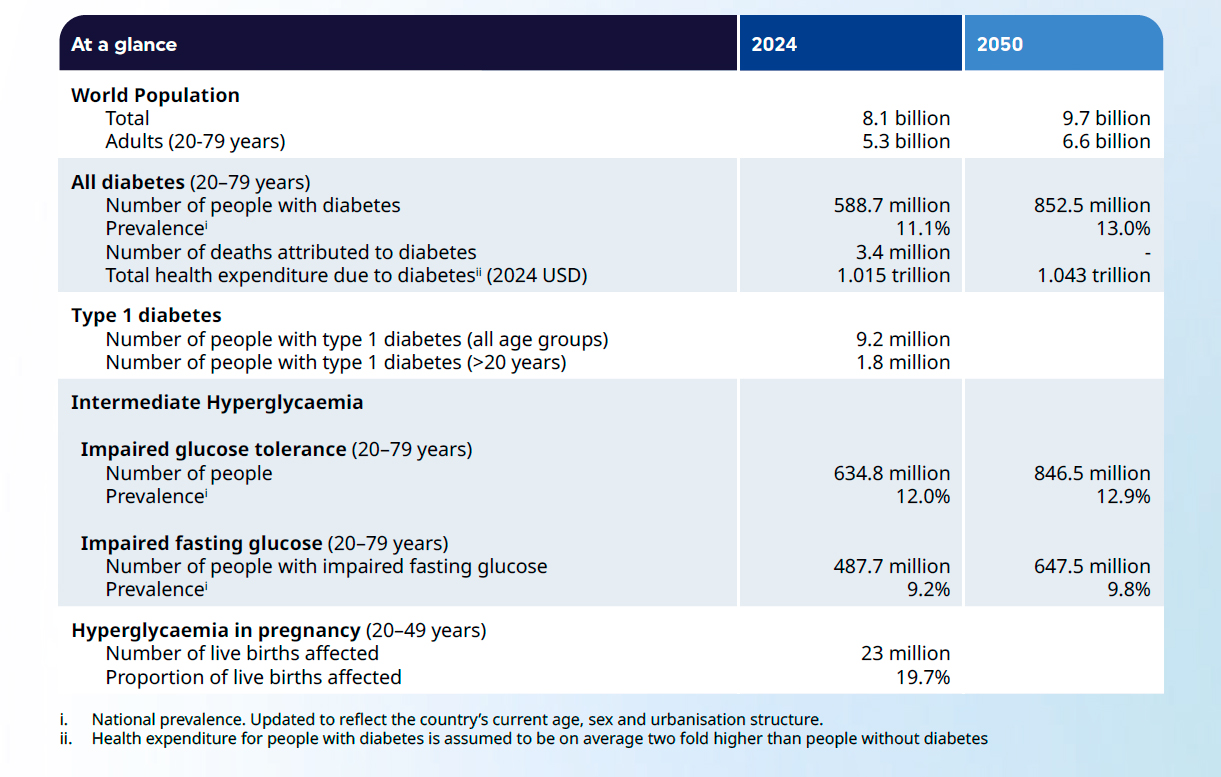
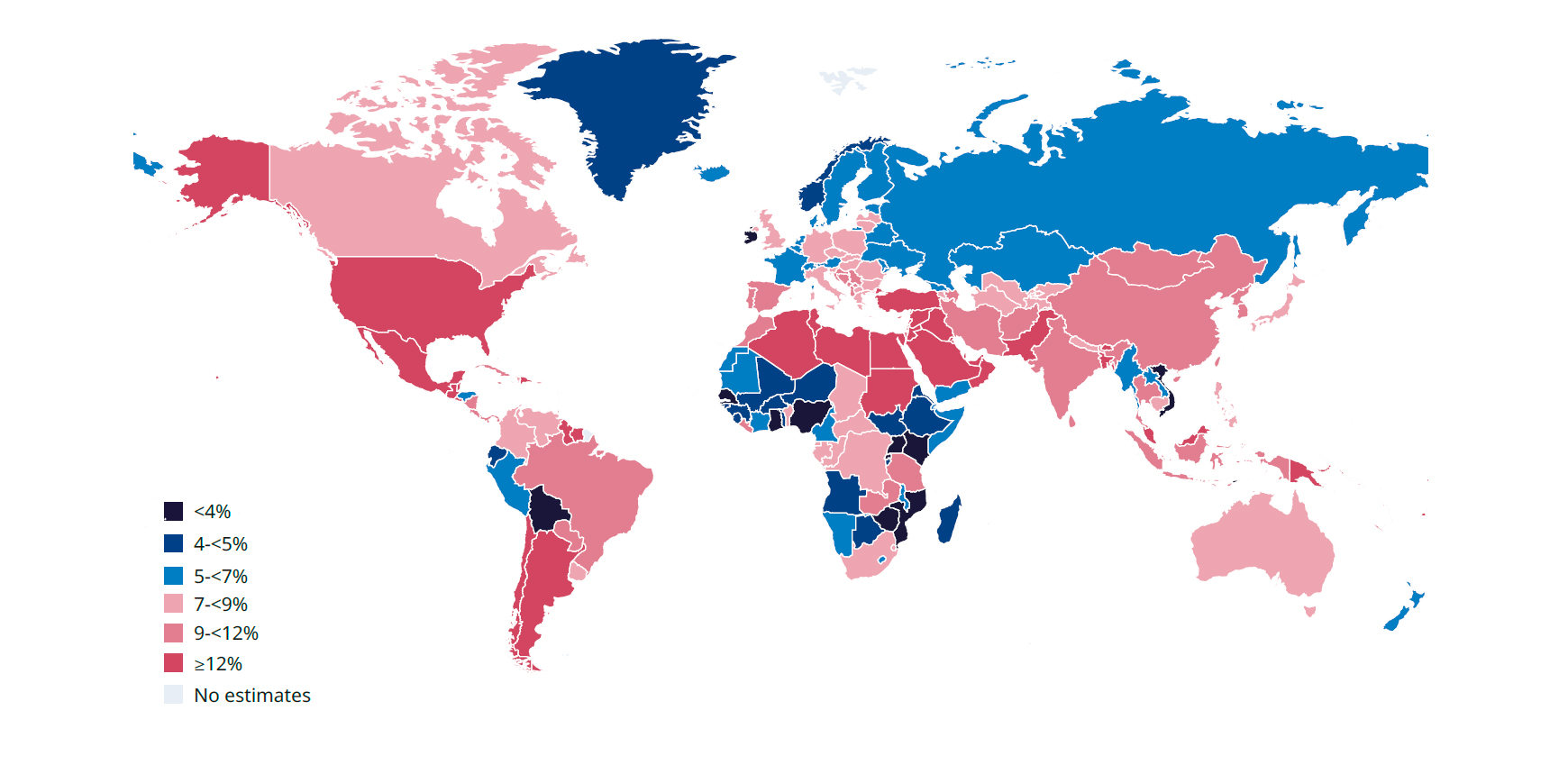
In 2024, more people with diabetes were living in urban (399.6 million) than rural (189.1 million) areas – the prevalence in urban areas was 12.7% and in rural areas 8.8%. The number of people with diabetes living in urban areas is expected to increase to 654.7 million, while the number in rural areas should remain stable (Figure 2.3). The projected prevalence is expected to reach 14.5% and 9.6% in urban and rural settings, respectively.
The MENA Region had the highest age-standardised diabetes prevalence (19.9%) in people aged 20–79 years in 2024. This estimate is expected to increase, with the MENA Region continuing to have the highest age-standardised revalence in 2050 (22.8%). The AFR Region currently has the lowest age-standardised estimates of prevalence (5.0% in 2024 and 5.9% in 2050), which can be attributed in part to low levels of urbanisation and low prevalence of overweight and obesity. The increase in percentage points over time is smaller than in other IDF regions (Table 2.3). This is likely to be underestimated given the rapid urbanisation and expected changes in lifestyles and ecosystems in this region.
Country distribution
The countries with the largest numbers of adults with diabetes aged 20–79 years in 2024 are China, India, and the USA. Pakistan is predicted to overtake the USA in the ranking of the estimated number of people with diabetes by 2050 (Table 2.4). Because of differences in population sizes, the countries with the highest number of people with diabetes do not necessarily have the highest prevalence. Differences in age distribution across countries affect rankings of the number of people with diabetes and the world-standardised prevalence estimates.
The highest age-standardised diabetes prevalence rates in 2024 were reported in Pakistan (31.4%), Marshall Islands (25.7%), and Kuwait (25.6%) (Table 3.5). The countries that are expected to have the highest overall age-standardised diabetes prevalence in 2050 are almost the same, with Pakistan reaching 34.2%, Marshall Islands 28.7% and Kiribati 28.5%.
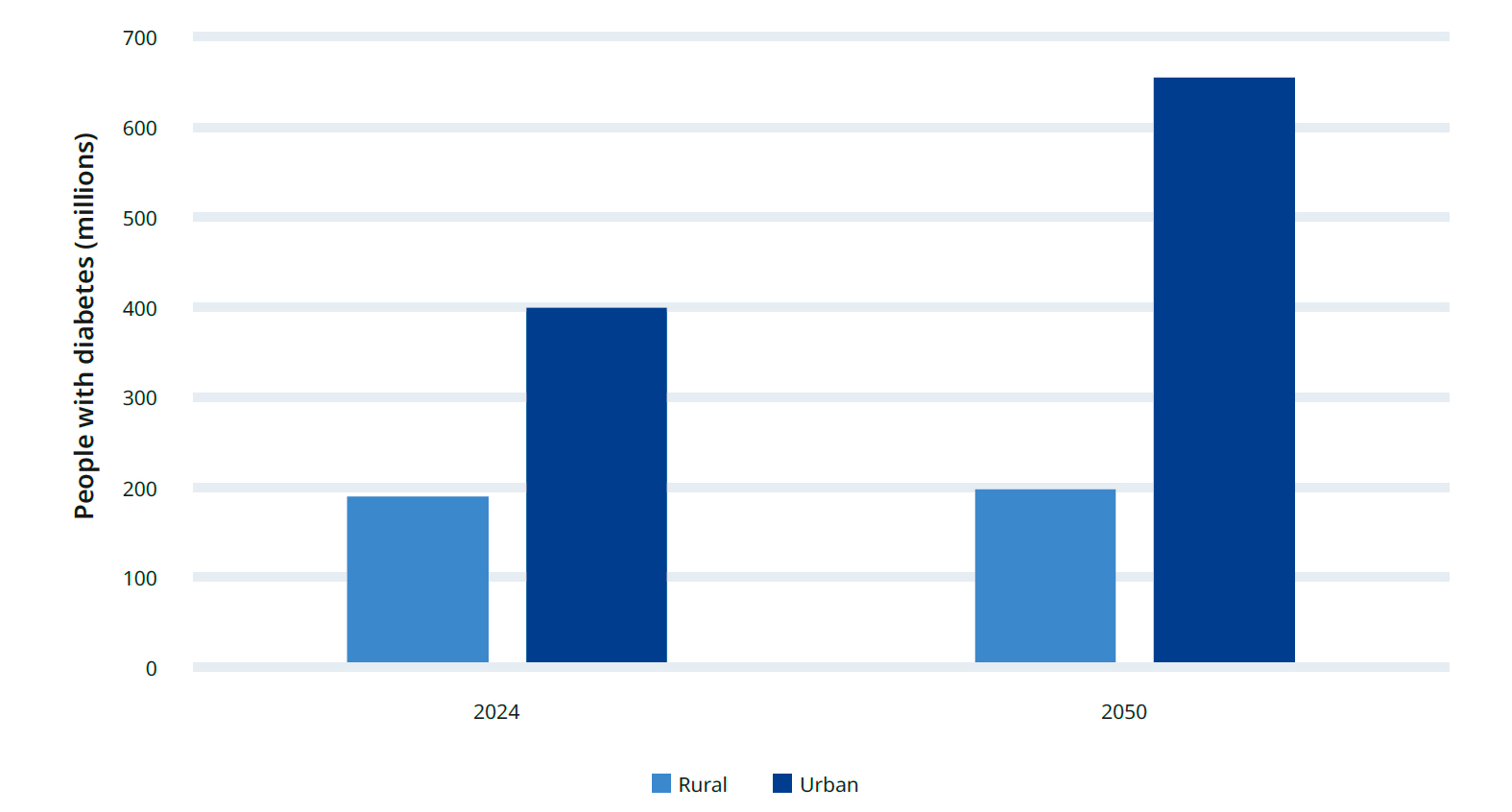
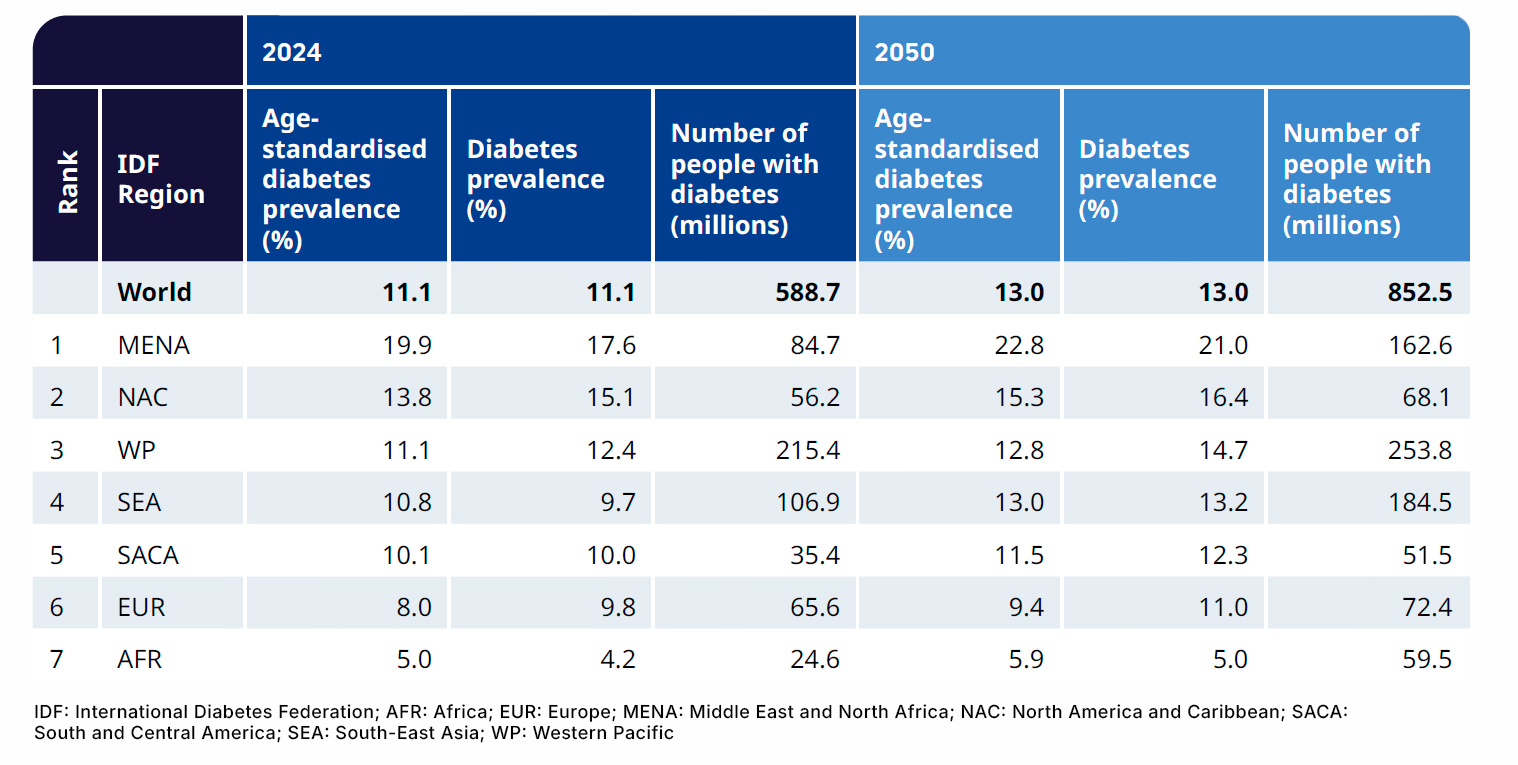
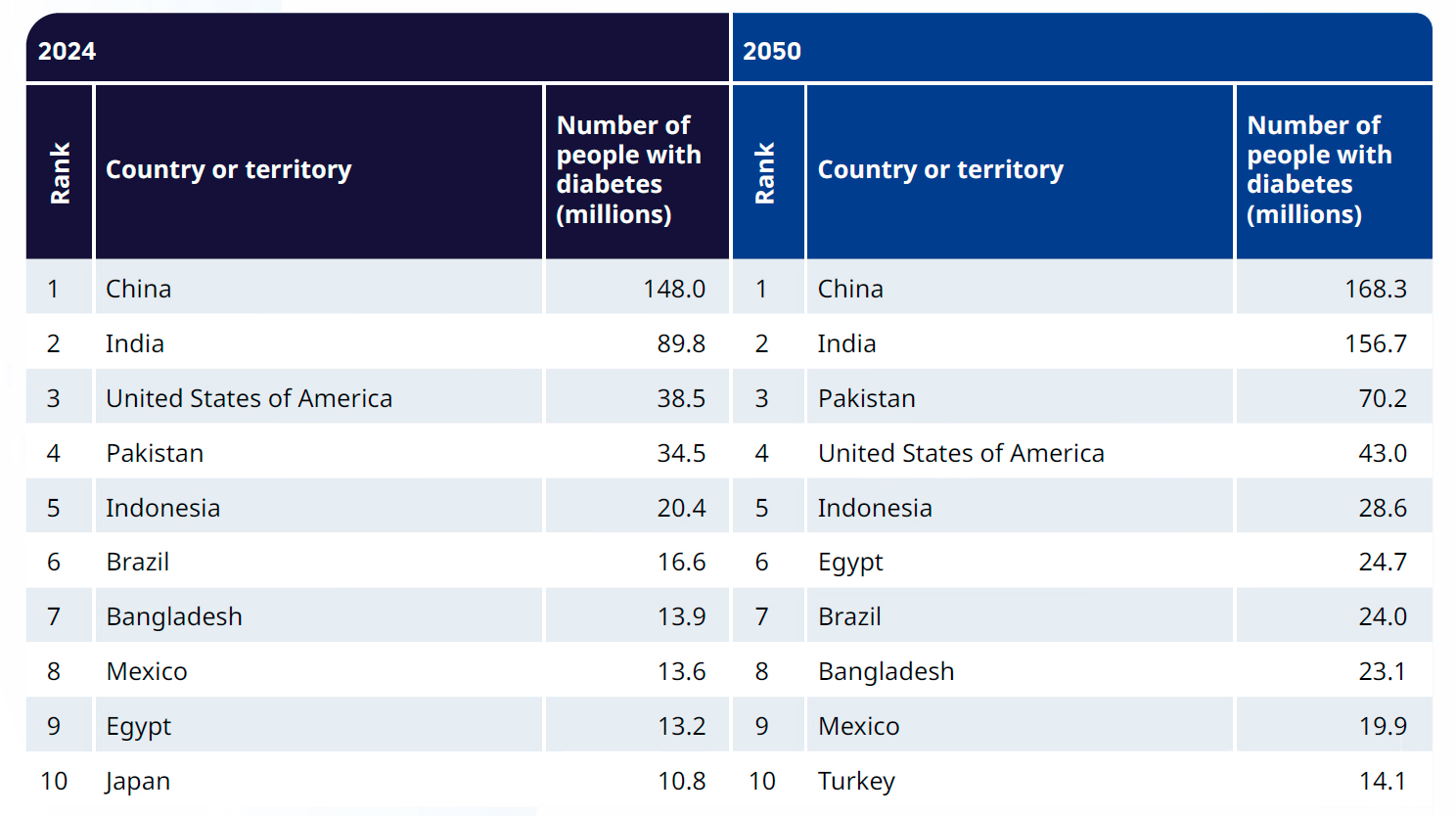
Diabetes prevalence in older adults in 2024 and projection to 2050
Diabetes prevalence increases with age. Therefore, the highest estimated prevalence is in people over 65 (Figure 2.1). In 2024, the estimated number of people with diabetes aged 65–99 years was 158.3 million (23.7%). If the current trend continues, the number of people aged 65-99 years with diabetes will be 278 million in 2050 (Table 2.6). These data point to a significant increase in the diabetes population of ageing societies in the next 25 years and the inevitable public health and economic challenges this will bring. It will require all countries to commit to sufficient resources to tackle diabetes.
Regional distribution
There are significant regional differences in the prevalence of diabetes in people over 65. Regions included in the top five places remained the same in 2024 compared with 2019, but the MENA region had the highest prevalence at (32.3%). The lowest prevalence remains in the AFR region (7.8%). This is generally true for 2050 as well (Table 2.7). However, the EUR region will fall to 6th place in the table with the SEA region taking its place. Overall, the projected diabetes prevalence in 2050 in this age group does not forecast significant increases. As an example, in the SACA Region the figures are 23.2% in 2024 and 23.6% in 2050, and in AFR 7.8% in 2024 and 8.3% in 2050.
Country distribution
The countries with the highest number of people over 65 with diabetes are China, India and the USA. India ranked higher than the USA in the number of people over 65 with diabetes for 2024 and 2050. (Map 2.3 and Table 2.8). Projected rises by 2050 are shown and indicate that Germany and the Russian Federation will be replaced by Turkey and Egypt in the top 10 list of countries with for people over 65 with diabetes.
Type 1 diabetes in older adults
The global number of type 1 diabetes in adults is estimated to be 9.15 million, of which 1.1 million are over 60, with a breakdown by age 655,000 (60-69), 325,000 (70-79), and 81,000 (80 and above).
Mortality and health expenditure in older adults
Total global mortality for people with diabetes over 60 is 2.2 million, and 9.2% of all-cause mortality deaths were due to diabetes in this age group. In 2024, 63% of deaths due to diabetes were in people over 60, and total health expenditure for people with diabetes over 60 is a staggering USD501.9 billion.
Undiagnosed diabetes
Estimates of undiagnosed diabetes were generated using 193 data sources from 109 countries. For the remaining 106 countries, which either lacked data sources or data sources did not meet the quality criteria for inclusion, the prevalence of undiagnosed diabetes was extrapolated. In 2024, just over four in ten (42.8%; 251.7 million) adults living with diabetes (20–79 years old) were undiagnosed. High prevalence of undiagnosed diabetes is often the result of insufficient access to healthcare services, as well as a limited capacity of health systems to identify diabetes cases.
Early diagnosis and the timely initiation of treatment are crucial for individuals with diabetes to prevent or delay complications, avoid premature death, and improve quality of life.
Furthermore, the early detection and management of diabetes can help avoid substantial costs related to diabetes complications.
Scaling-up cost-effective diabetes screening and diagnostic capacity is a crucial first step towards improving care for people with diabetes.
Global and regional disparities in undiagnosed diabetes
Across low-income, middle-income, and high-income countries, 58.7%, 45.5%, and 28.9% of adults living with diabetes are undiagnosed (Table 2.9). Globally, 86.9% of all people with undiagnosed diabetes live in low- and middle-income countries, home to four-fifths of the world’s population.
There are large differences in the proportion of undiagnosed diabetes across IDF regions. The highest proportion of undiagnosed diabetes is found in Africa (72.6%), followed by the Western Pacific (50.0%), and South-East Asia (42.7%) (Table 2.10). The lowest proportion of undiagnosed diabetes is found in North America and Caribbean (29.1%). Variation in undiagnosed diabetes across regions and countries is often linked to several factors, including social and economic conditions, health system performance, and awareness about diabetes among health professionals and the public.
The proportion of people living with undiagnosed diabetes varies by country (Map 2.4). Colombia (16.2%), Hungary (16.7%), and the Czech Republic (16.7%) have the lowest proportions of undiagnosed diabetes, whereas Burkina Faso (90.4%), Benin (89.8%), and Mozambique (88.6%) have the highest. In absolute terms, 50.5% of all people with undiagnosed diabetes globally live in just three countries, namely China, India, and Indonesia (Table 2.11). These three countries are among the four most populous countries in the world and among the top five countries in terms of number of people with diabetes (Table 2.4).
To improve estimates of undiagnosed diabetes and guide health-system responses, investments in surveillance and monitoring systems for diabetes are urgently needed. Crucially, data quality depends on the collection of diabetes biomarkers in population-based studies. For reliable estimates, a combination of both HbA1c and FPG is recommended. However, diabetes monitoring efforts, particularly in low-resource settings, will need to balance diagnostic accuracy of different diabetes tests with their feasibility and the cost of implementation. Globally, more than four in ten adults with diabetes in 2024 were unaware that they have the condition. This translates to 252 million people living with undiagnosed – and therefore untreated – diabetes, placing them at increased risk of complications and premature death. Thus, there is a clear need to scale up screening programmes and high-quality, personcentred health services, especially in low- and middleincome countries, where over 85% of people with undiagnosed diabetes live.
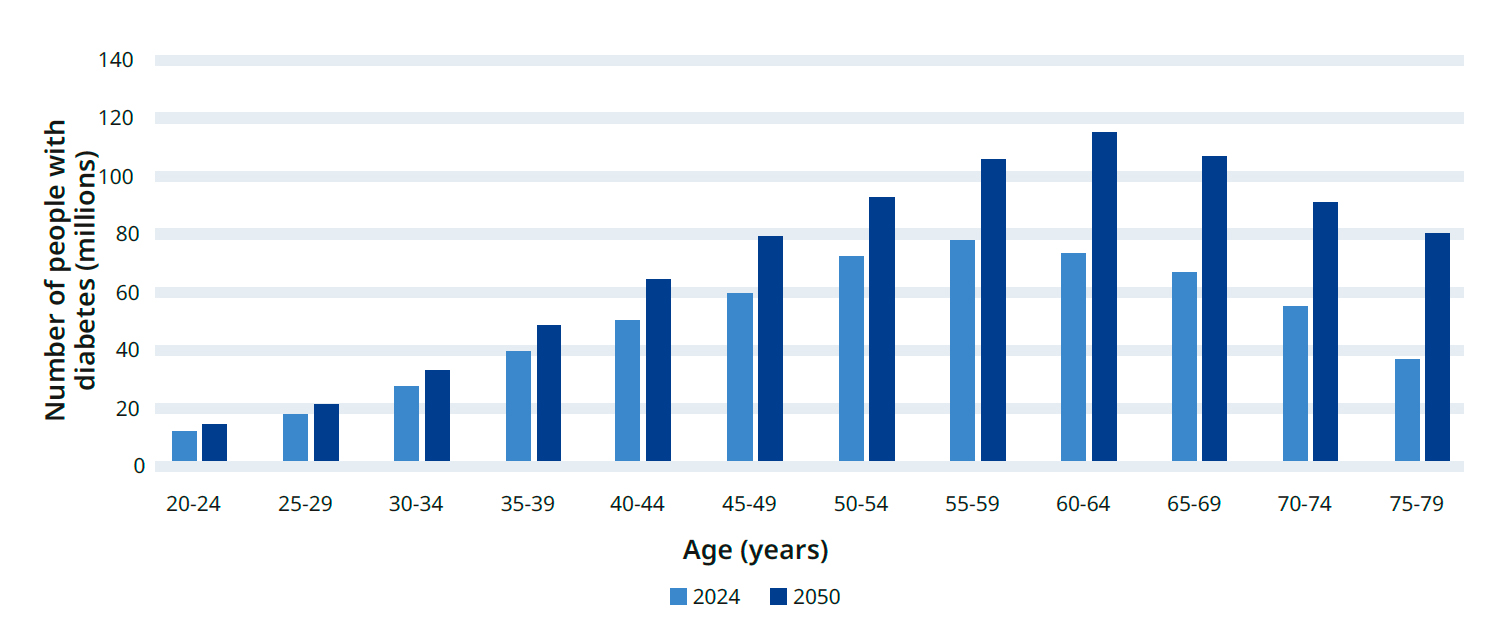

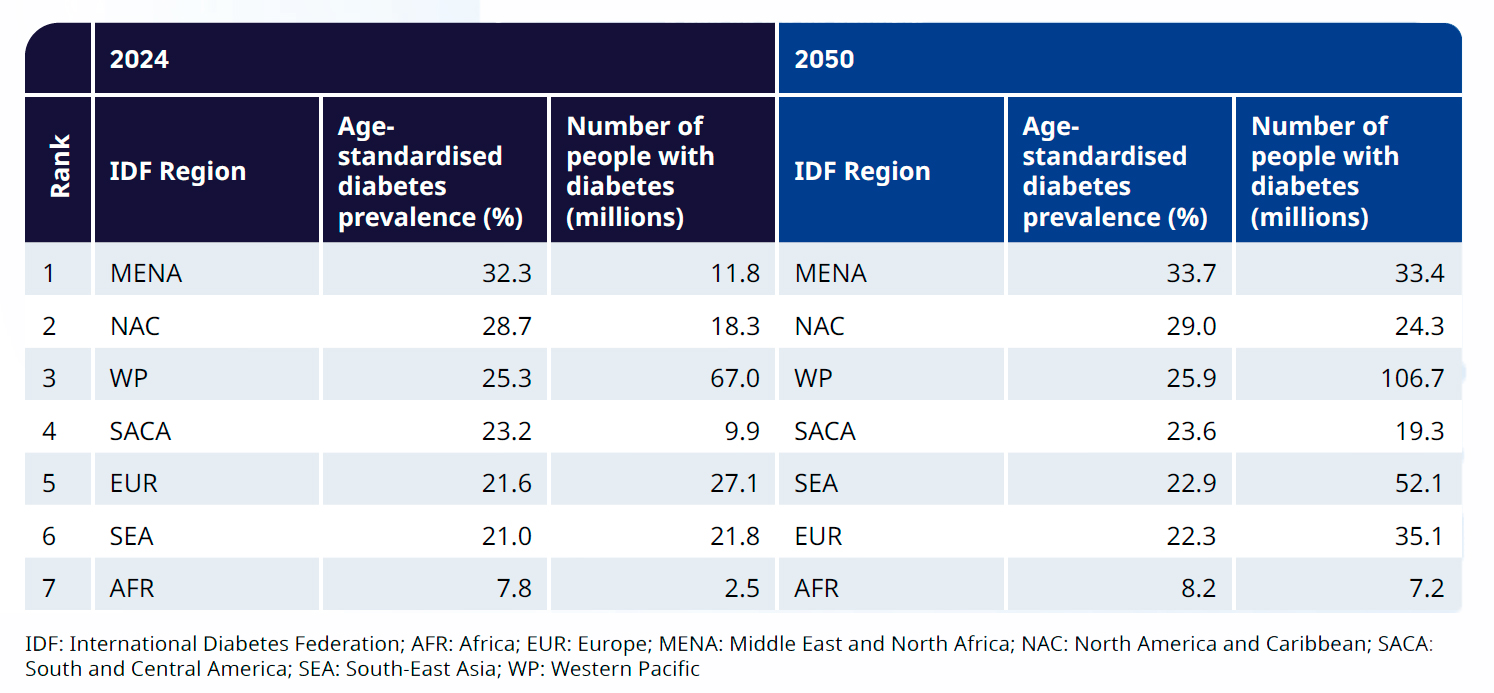
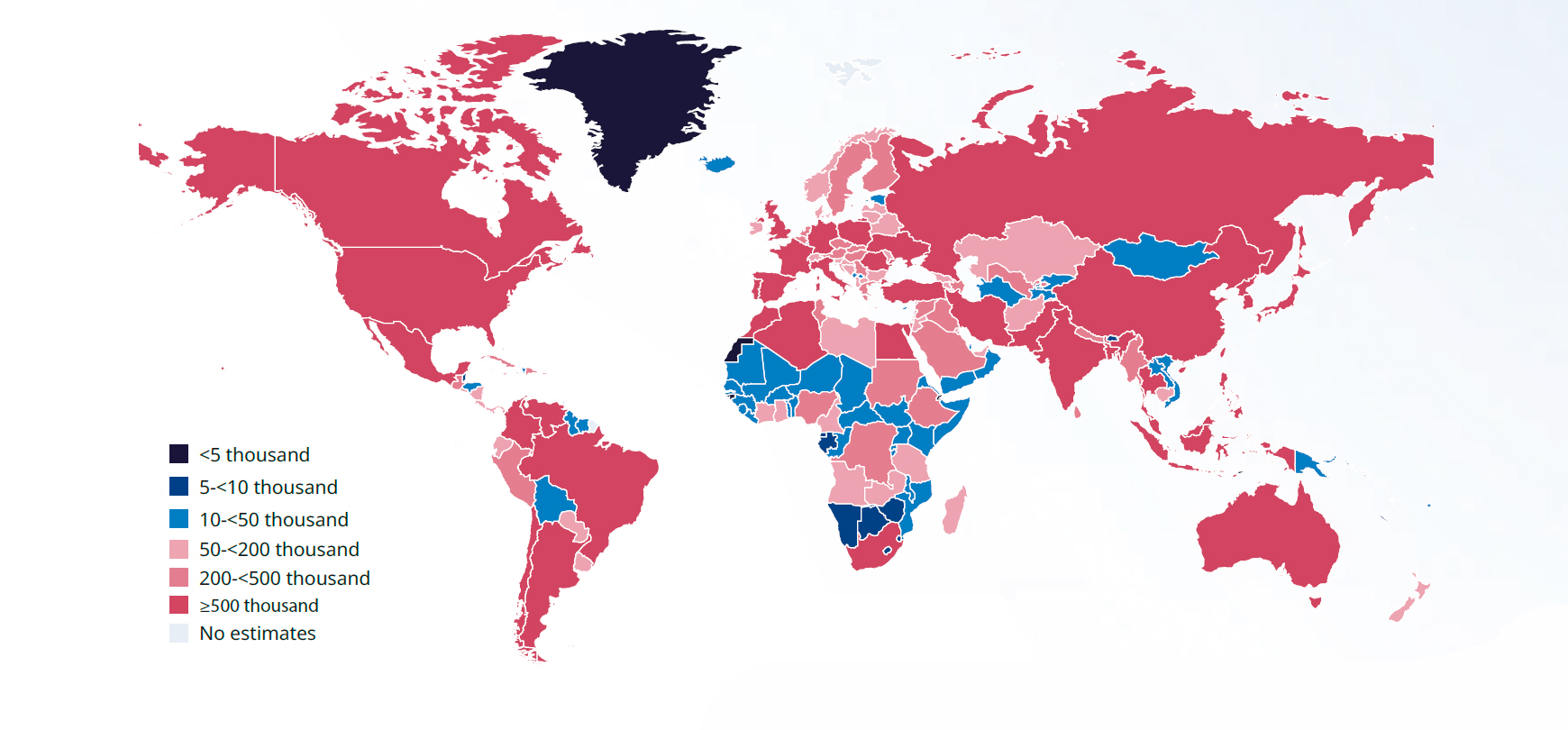
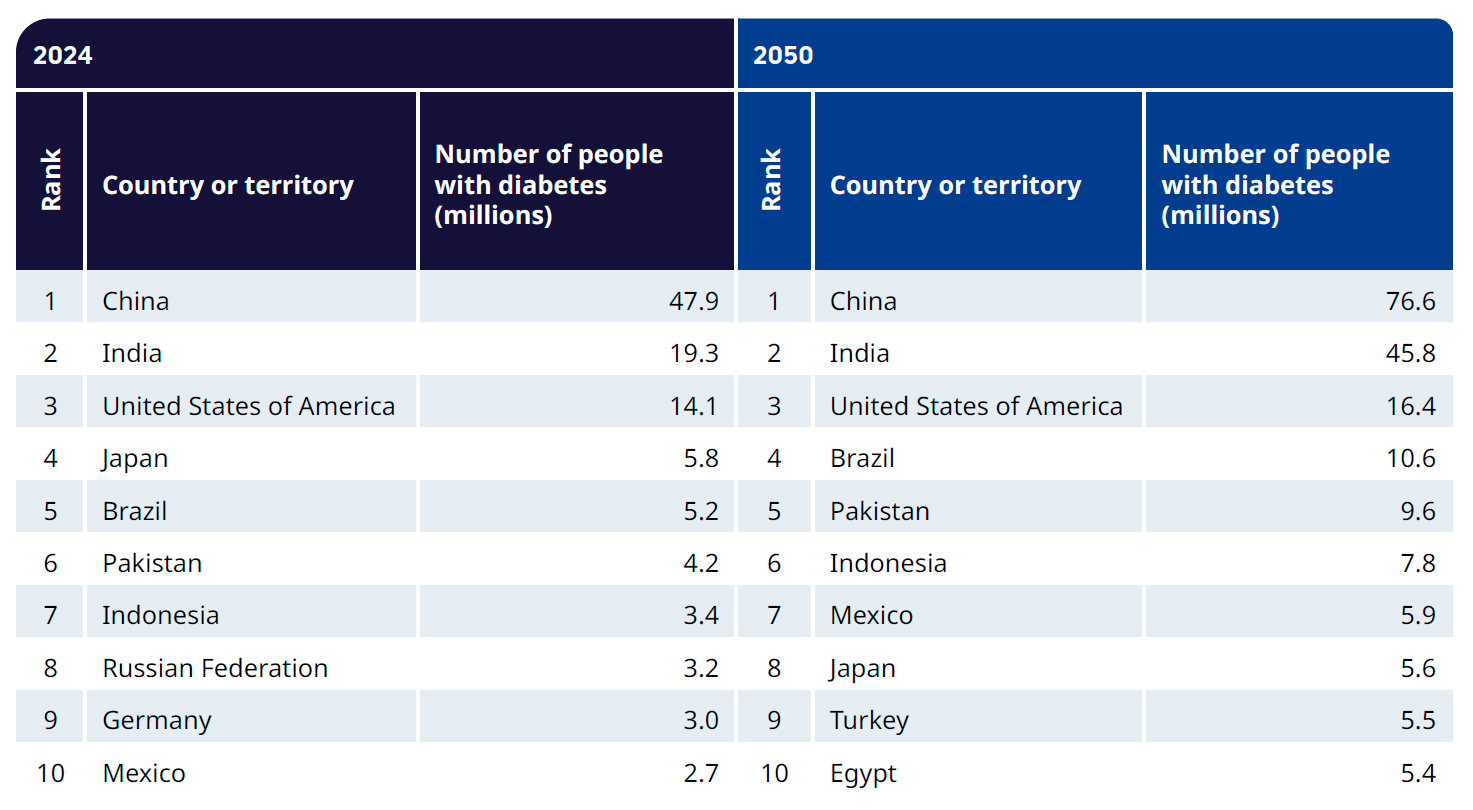

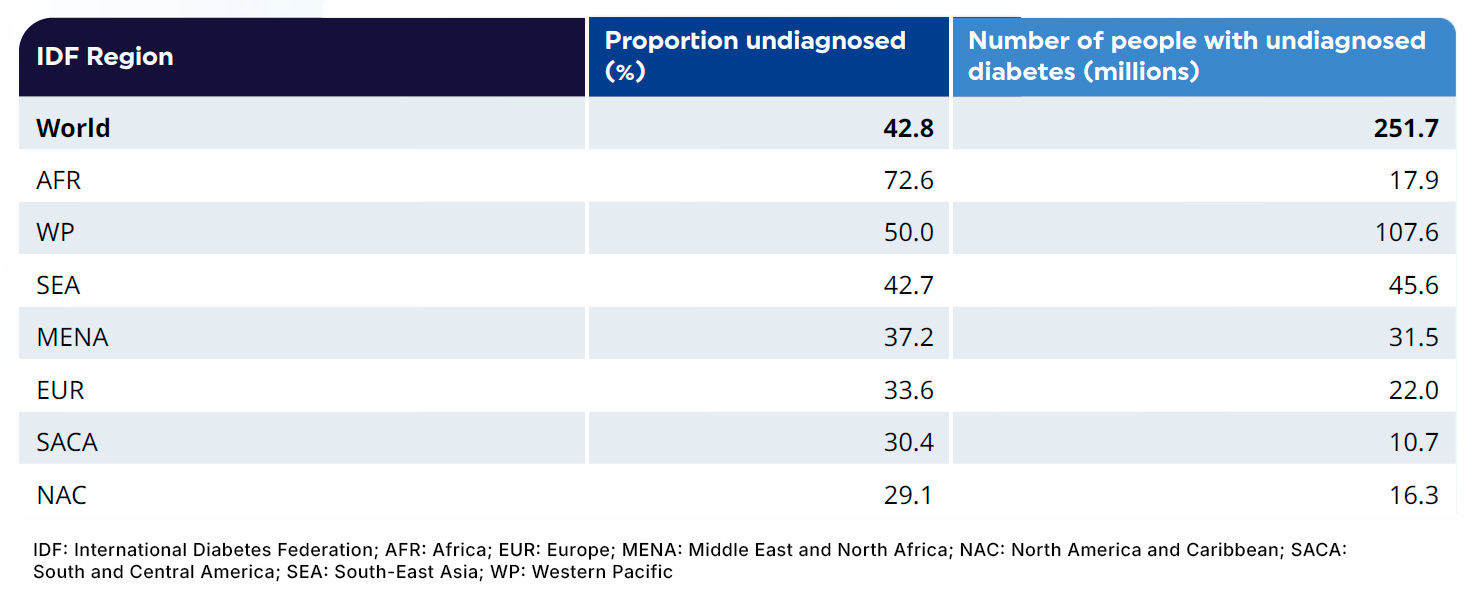
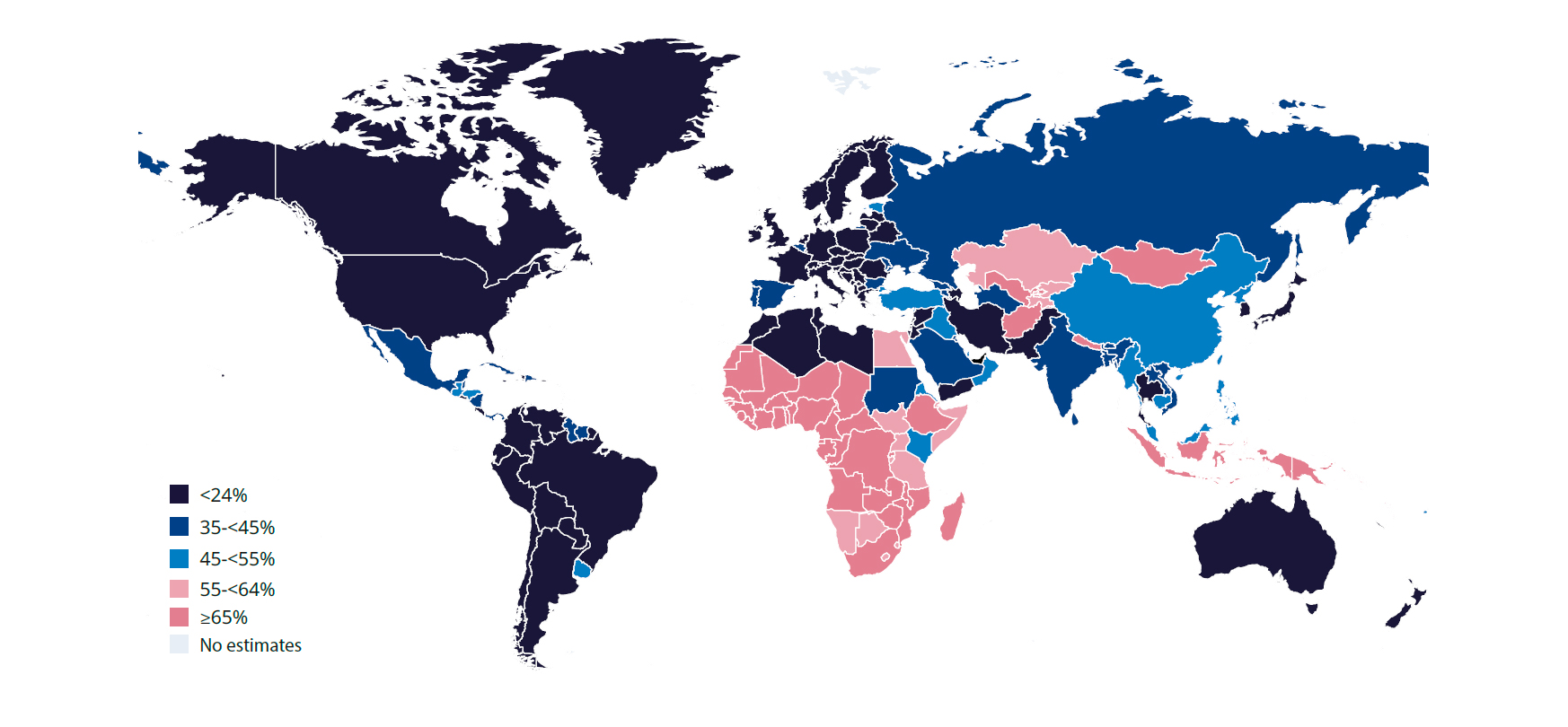
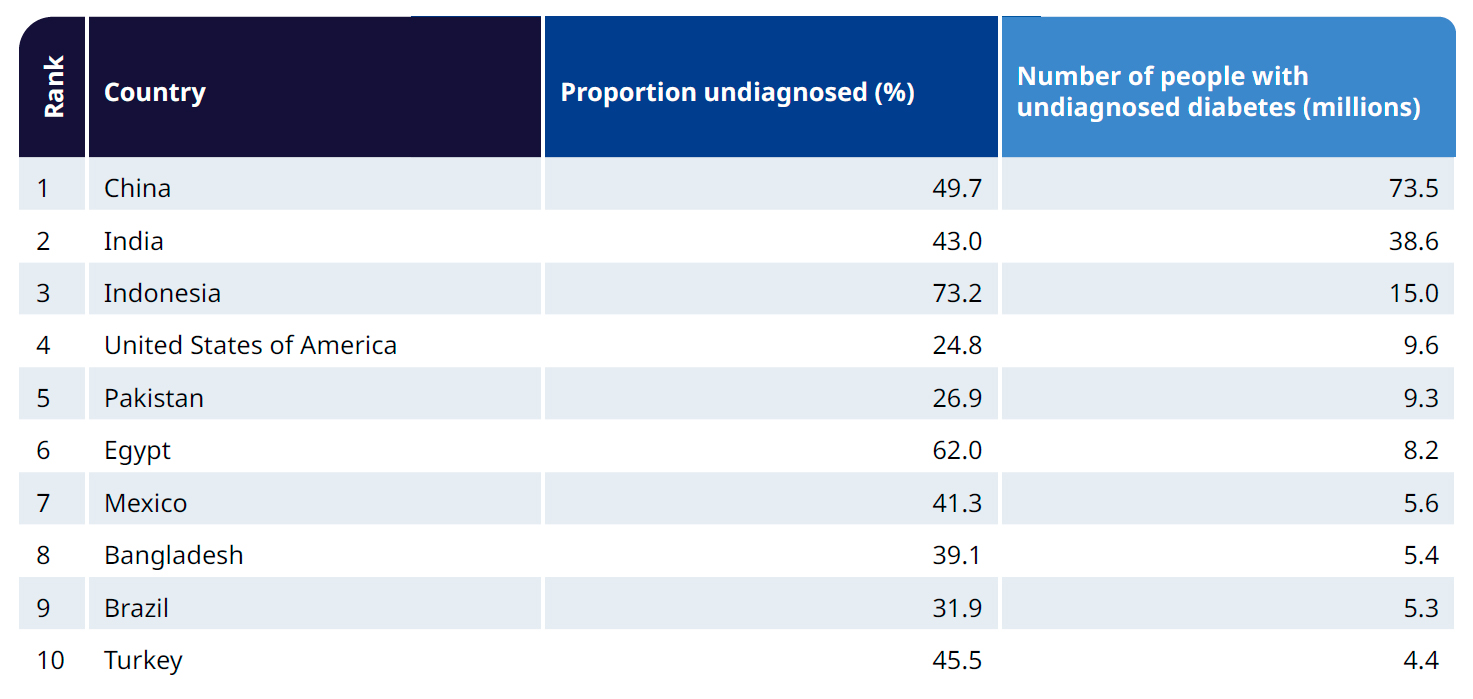
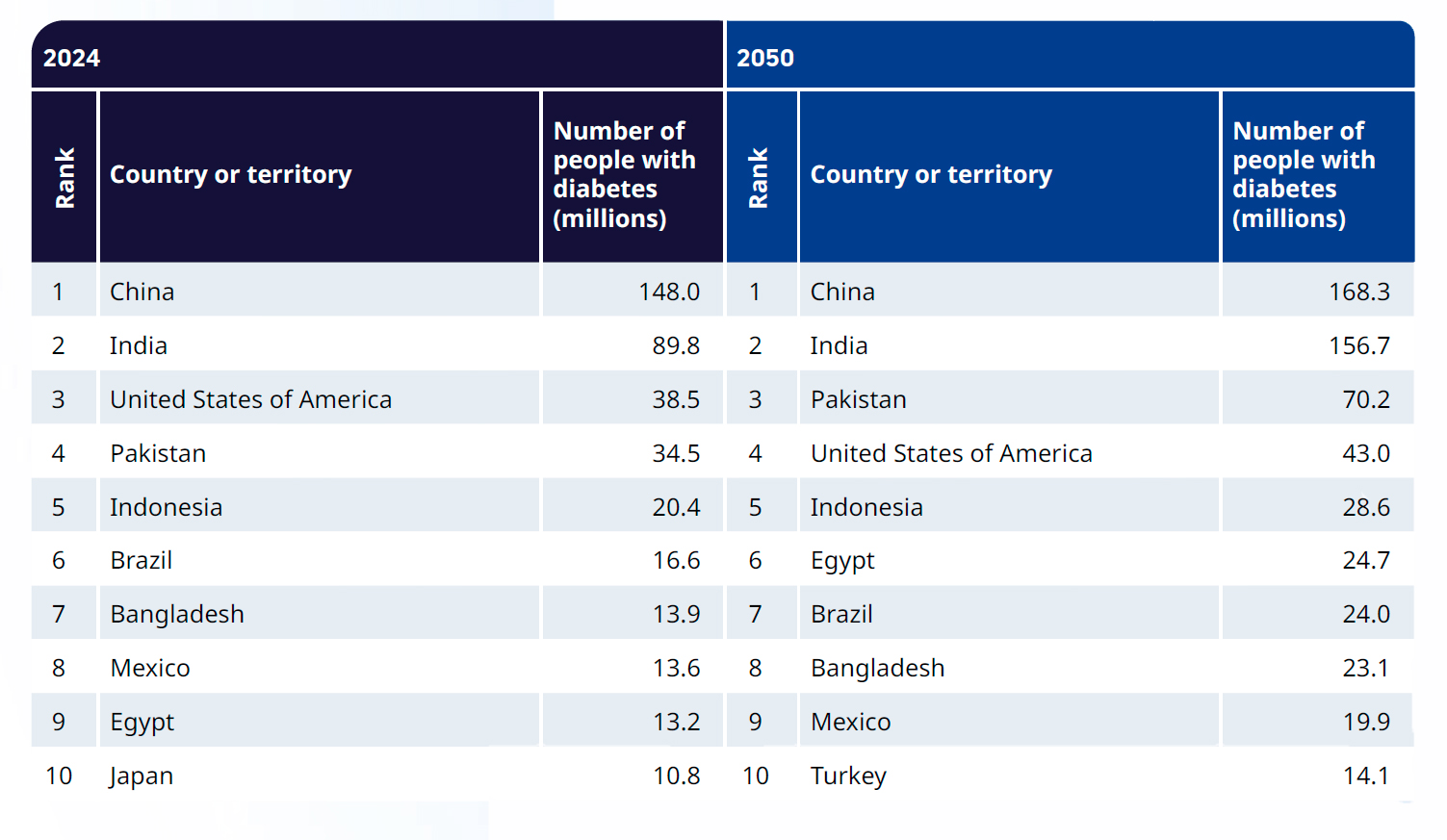
Top 10 countries or territories by number of adults (20–79 years) with diabetes in 2024 and 2050.
Country or territory
- 1.China
- 2.India
- 3.USA
- 4.Pakistan
- 5.Indonesia
- 6.Brazil
- 7.Bangladesh
- 8.Mexico
- 9.Egypt
- 10.Japan
Number of people with diabetes in 2024
- 148.0 millions
- 89.8 millions
- 38.5 millions
- 34.5 millions
- 20.4 millions
- 16.6 millions
- 13.9 millions
- 13.6 millions
- 13.2 millions
- 10.8 millions
Country or territory
- 1.China
- 2.India
- 3.Pakistan
- 4.USA
- 5.Indonesia
- 6.Egypt
- 7.Brazil
- 8.Bangladesh
- 9.Mexico
- 10.Turkey
Number of people with diabetes in 2050
- 168.3 millions
- 156.7 millions
- 70.2 millions
- 43.0 millions
- 28.6 millions
- 24.7 millions
- 24.0 millions
- 23.1 millions
- 19.9 millions
- 14.1 millions

Diabetes-related mortality
Diabetes is a significant cause of mortality worldwide, though its impact varies by region due to differences in the prevalence of diabetes, age distribution and the role of other contributing causes of death. Approximately 3.4 million adults aged 20-79 years are estimated to have died because of diabetes or its complications in 2024 (2.4 million diagnosed diabetesrelated deaths and 1 million undiagnosed diabetesrelated deaths). This corresponds to 9.3% of global deaths from all causes in this age group. Almost 40% of the estimated number of deaths related to diabetes occurred in the most economically active age group (20-59 years) (Figure 2.6). Diabetes led to nearly one in ten (9.3%) of all deaths in this age group. The 2024 estimates for the number of deaths related to diabetes are lower than in prior editions of Diabetes Atlas due to multiple changes in methodology. The original source data for overall country-level mortality data was switched from an older WHO source to an updated United Nations source. The updated United Nations source has lower overall mortality numbers. In addition, the new estimates now account for mortality risk differences between diagnosed and undiagnosed diabetes. Relative risks of mortality compared to people without diabetes are generally lower in individuals with undiagnosed vs diagnosed diabetes.
Regional distribution
The IDF Western Pacific Region has the highest estimated number of diabetes-related deaths among adults aged 20-79 years of all the IDF Regions, with approximately 1.2 million deaths. This is followed by NAC, with approximately 0.53 million deaths. The IDF Regions with the lowest number of deaths are AFR and SACA, with approximately 0.22 million deaths each. These regional discrepancies are largely driven by the relative size of their respective populations with diabetes and their age distribution. The proportion of total deaths associated with diabetes is an indicator of the relative mortality burden of diabetes within each IDF Region. Diabetes is associated with the highest percentage of deaths from all causes in NAC at 21.4% (Map 3.7). The second highest region is MENA, with 16.7% of all deaths associated with diabetes. The IDF Region with the lowest percentage of deaths associated with diabetes is AFR, at 4.0%.
Country distribution
Partly due to its large population, China has the highest estimated number of deaths from diabetes, at approximately 0.76 million. Due to its large population and high prevalence of diabetes, the USA has the second highest number of deaths with 0.36 million. The next highest is India (0.33 million), followed by Pakistan (0.23 million), Indonesia (0.13 million) and Mexico (0.12 million). The countries with the highest proportion of total deaths associated with diabetes are Guam (36%), New Caledonia (34%), French Polynesia (31%), Israel (30%), and Italy (29%). The countries with the lowest proportions are Russia (0.42%), followed by Zimbabwe and Rwanda, each with approximately 1.3% of total deaths estimated to be associated with diabetes.








